Itinerary
On one of the best stretches of the Mediterranean, this classic luxury destination is one of the most sought-after addresses in the world. With all the high-rise towers you have to look hard to find the Belle Époque grace of yesteryear. But if you head to the town’s great 1864 landmark Hôtel de Paris—still a veritable crossroads of the buffed and befurred Euro-gentry—or enjoy a grand bouffe at its famous Louis XV restaurant, or attend the opera, or visit the ballrooms of the casino, you may still be able to conjure up Monaco’s elegant past. Prince Albert II, a political science graduate from Amherst College, traces his ancestry to Otto Canella, who was born in 1070. The Grimaldi dynasty began with Otto’s great-great-great-grandson, Francesco Grimaldi, also known as Frank the Rogue. Expelled from Genoa, Frank and his cronies disguised themselves as monks and in 1297 seized the fortified medieval town known today as Le Rocher (the Rock). Except for a short break under Napoléon, the Grimaldis have been here ever since, which makes them the oldest reigning family in Europe. In the 1850s a Grimaldi named Charles III made a decision that turned the Rock into a giant blue chip. Needing revenue but not wanting to impose additional taxes on his subjects, he contracted with a company to open a gambling facility. The first spin of the roulette wheel was on December 14, 1856. There was no easy way to reach Monaco then—no carriage roads or railroads—so no one came. Between March 15 and March 20, 1857, one person entered the casino—and won two francs. In 1868, however, the railroad reached Monaco, and it was filled with Englishmen who came to escape the London fog. The effects were immediate. Profits were so great that Charles eventually abolished all direct taxes. Almost overnight, a threadbare principality became an elegant watering hole for European society. Dukes (and their mistresses) and duchesses (and their gigolos) danced and dined their way through a world of spinning roulette wheels and bubbling champagne—preening themselves for nights at the opera, where such artists as Vaslav Nijinsky, Sarah Bernhardt, and Enrico Caruso came to perform. Along with the tax system, its sensational position on a broad, steep peninsula that bulges into the Mediterranean—its harbor sparkling with luxury cruisers, its posh mansions angling awnings toward the nearly perpetual sun—continues to draw the rich and famous. One of the latest French celebrities to declare himself “Monégasque,” thus giving up his French passport, is superchef Alain Ducasse, who said that he made the choice out of affection for Monaco rather than tax reasons. Pleasure boats vie with luxury cruisers in their brash beauty and Titanic scale, and teams of handsome young men—themselves dyed blond and tanned to match—scour and polish every gleaming surface. As you might expect, all this glitz doesn’t come cheap. Eating is expensive, and even the most modest hotels cost more here than in nearby Nice or Menton. As for taxis, they don’t even have meters so you are completely at the driver’s mercy (with prices skyrocketing during events such as the Grand Prix). For the frugal, Monaco is the ultimate day-trip, although parking is as coveted as a room with a view. At the very least you can afford a coffee at Starbucks. The harbor district, known as La Condamine, connects the new quarter, officially known as Monte Carlo with Monaco-Ville (or Le Rocher), a medieval town on the Rock, topped by the palace, the cathedral, and the Oceanography Museum. Have no fear that you’ll need to climb countless steps to get to Monaco-Ville, as there are plenty of elevators and escalators climbing the steep cliffs. But shuttling between the lovely casino grounds of Monte Carlo and Old Monaco, separated by a vast port, is a daunting proposition for ordinary mortals without wings, so hop on the No. 1 bus from Saint Roman, or No. 2 from the Jardin Exotique – Both stop at Place du Casino and come up to Monaco Ville.
On one of the best stretches of the Mediterranean, this classic luxury destination is one of the most sought-after addresses in the world. With all the high-rise towers you have to look hard to find the Belle Époque grace of yesteryear. But if you head to the town’s great 1864 landmark Hôtel de Paris—still a veritable crossroads of the buffed and befurred Euro-gentry—or enjoy a grand bouffe at its famous Louis XV restaurant, or attend the opera, or visit the ballrooms of the casino, you may still be able to conjure up Monaco’s elegant past. Prince Albert II, a political science graduate from Amherst College, traces his ancestry to Otto Canella, who was born in 1070. The Grimaldi dynasty began with Otto’s great-great-great-grandson, Francesco Grimaldi, also known as Frank the Rogue. Expelled from Genoa, Frank and his cronies disguised themselves as monks and in 1297 seized the fortified medieval town known today as Le Rocher (the Rock). Except for a short break under Napoléon, the Grimaldis have been here ever since, which makes them the oldest reigning family in Europe. In the 1850s a Grimaldi named Charles III made a decision that turned the Rock into a giant blue chip. Needing revenue but not wanting to impose additional taxes on his subjects, he contracted with a company to open a gambling facility. The first spin of the roulette wheel was on December 14, 1856. There was no easy way to reach Monaco then—no carriage roads or railroads—so no one came. Between March 15 and March 20, 1857, one person entered the casino—and won two francs. In 1868, however, the railroad reached Monaco, and it was filled with Englishmen who came to escape the London fog. The effects were immediate. Profits were so great that Charles eventually abolished all direct taxes. Almost overnight, a threadbare principality became an elegant watering hole for European society. Dukes (and their mistresses) and duchesses (and their gigolos) danced and dined their way through a world of spinning roulette wheels and bubbling champagne—preening themselves for nights at the opera, where such artists as Vaslav Nijinsky, Sarah Bernhardt, and Enrico Caruso came to perform. Along with the tax system, its sensational position on a broad, steep peninsula that bulges into the Mediterranean—its harbor sparkling with luxury cruisers, its posh mansions angling awnings toward the nearly perpetual sun—continues to draw the rich and famous. One of the latest French celebrities to declare himself “Monégasque,” thus giving up his French passport, is superchef Alain Ducasse, who said that he made the choice out of affection for Monaco rather than tax reasons. Pleasure boats vie with luxury cruisers in their brash beauty and Titanic scale, and teams of handsome young men—themselves dyed blond and tanned to match—scour and polish every gleaming surface. As you might expect, all this glitz doesn’t come cheap. Eating is expensive, and even the most modest hotels cost more here than in nearby Nice or Menton. As for taxis, they don’t even have meters so you are completely at the driver’s mercy (with prices skyrocketing during events such as the Grand Prix). For the frugal, Monaco is the ultimate day-trip, although parking is as coveted as a room with a view. At the very least you can afford a coffee at Starbucks. The harbor district, known as La Condamine, connects the new quarter, officially known as Monte Carlo with Monaco-Ville (or Le Rocher), a medieval town on the Rock, topped by the palace, the cathedral, and the Oceanography Museum. Have no fear that you’ll need to climb countless steps to get to Monaco-Ville, as there are plenty of elevators and escalators climbing the steep cliffs. But shuttling between the lovely casino grounds of Monte Carlo and Old Monaco, separated by a vast port, is a daunting proposition for ordinary mortals without wings, so hop on the No. 1 bus from Saint Roman, or No. 2 from the Jardin Exotique – Both stop at Place du Casino and come up to Monaco Ville.
On one of the best stretches of the Mediterranean, this classic luxury destination is one of the most sought-after addresses in the world. With all the high-rise towers you have to look hard to find the Belle Époque grace of yesteryear. But if you head to the town’s great 1864 landmark Hôtel de Paris—still a veritable crossroads of the buffed and befurred Euro-gentry—or enjoy a grand bouffe at its famous Louis XV restaurant, or attend the opera, or visit the ballrooms of the casino, you may still be able to conjure up Monaco’s elegant past. Prince Albert II, a political science graduate from Amherst College, traces his ancestry to Otto Canella, who was born in 1070. The Grimaldi dynasty began with Otto’s great-great-great-grandson, Francesco Grimaldi, also known as Frank the Rogue. Expelled from Genoa, Frank and his cronies disguised themselves as monks and in 1297 seized the fortified medieval town known today as Le Rocher (the Rock). Except for a short break under Napoléon, the Grimaldis have been here ever since, which makes them the oldest reigning family in Europe. In the 1850s a Grimaldi named Charles III made a decision that turned the Rock into a giant blue chip. Needing revenue but not wanting to impose additional taxes on his subjects, he contracted with a company to open a gambling facility. The first spin of the roulette wheel was on December 14, 1856. There was no easy way to reach Monaco then—no carriage roads or railroads—so no one came. Between March 15 and March 20, 1857, one person entered the casino—and won two francs. In 1868, however, the railroad reached Monaco, and it was filled with Englishmen who came to escape the London fog. The effects were immediate. Profits were so great that Charles eventually abolished all direct taxes. Almost overnight, a threadbare principality became an elegant watering hole for European society. Dukes (and their mistresses) and duchesses (and their gigolos) danced and dined their way through a world of spinning roulette wheels and bubbling champagne—preening themselves for nights at the opera, where such artists as Vaslav Nijinsky, Sarah Bernhardt, and Enrico Caruso came to perform. Along with the tax system, its sensational position on a broad, steep peninsula that bulges into the Mediterranean—its harbor sparkling with luxury cruisers, its posh mansions angling awnings toward the nearly perpetual sun—continues to draw the rich and famous. One of the latest French celebrities to declare himself “Monégasque,” thus giving up his French passport, is superchef Alain Ducasse, who said that he made the choice out of affection for Monaco rather than tax reasons. Pleasure boats vie with luxury cruisers in their brash beauty and Titanic scale, and teams of handsome young men—themselves dyed blond and tanned to match—scour and polish every gleaming surface. As you might expect, all this glitz doesn’t come cheap. Eating is expensive, and even the most modest hotels cost more here than in nearby Nice or Menton. As for taxis, they don’t even have meters so you are completely at the driver’s mercy (with prices skyrocketing during events such as the Grand Prix). For the frugal, Monaco is the ultimate day-trip, although parking is as coveted as a room with a view. At the very least you can afford a coffee at Starbucks. The harbor district, known as La Condamine, connects the new quarter, officially known as Monte Carlo with Monaco-Ville (or Le Rocher), a medieval town on the Rock, topped by the palace, the cathedral, and the Oceanography Museum. Have no fear that you’ll need to climb countless steps to get to Monaco-Ville, as there are plenty of elevators and escalators climbing the steep cliffs. But shuttling between the lovely casino grounds of Monte Carlo and Old Monaco, separated by a vast port, is a daunting proposition for ordinary mortals without wings, so hop on the No. 1 bus from Saint Roman, or No. 2 from the Jardin Exotique – Both stop at Place du Casino and come up to Monaco Ville.
On one of the best stretches of the Mediterranean, this classic luxury destination is one of the most sought-after addresses in the world. With all the high-rise towers you have to look hard to find the Belle Époque grace of yesteryear. But if you head to the town’s great 1864 landmark Hôtel de Paris—still a veritable crossroads of the buffed and befurred Euro-gentry—or enjoy a grand bouffe at its famous Louis XV restaurant, or attend the opera, or visit the ballrooms of the casino, you may still be able to conjure up Monaco’s elegant past. Prince Albert II, a political science graduate from Amherst College, traces his ancestry to Otto Canella, who was born in 1070. The Grimaldi dynasty began with Otto’s great-great-great-grandson, Francesco Grimaldi, also known as Frank the Rogue. Expelled from Genoa, Frank and his cronies disguised themselves as monks and in 1297 seized the fortified medieval town known today as Le Rocher (the Rock). Except for a short break under Napoléon, the Grimaldis have been here ever since, which makes them the oldest reigning family in Europe. In the 1850s a Grimaldi named Charles III made a decision that turned the Rock into a giant blue chip. Needing revenue but not wanting to impose additional taxes on his subjects, he contracted with a company to open a gambling facility. The first spin of the roulette wheel was on December 14, 1856. There was no easy way to reach Monaco then—no carriage roads or railroads—so no one came. Between March 15 and March 20, 1857, one person entered the casino—and won two francs. In 1868, however, the railroad reached Monaco, and it was filled with Englishmen who came to escape the London fog. The effects were immediate. Profits were so great that Charles eventually abolished all direct taxes. Almost overnight, a threadbare principality became an elegant watering hole for European society. Dukes (and their mistresses) and duchesses (and their gigolos) danced and dined their way through a world of spinning roulette wheels and bubbling champagne—preening themselves for nights at the opera, where such artists as Vaslav Nijinsky, Sarah Bernhardt, and Enrico Caruso came to perform. Along with the tax system, its sensational position on a broad, steep peninsula that bulges into the Mediterranean—its harbor sparkling with luxury cruisers, its posh mansions angling awnings toward the nearly perpetual sun—continues to draw the rich and famous. One of the latest French celebrities to declare himself “Monégasque,” thus giving up his French passport, is superchef Alain Ducasse, who said that he made the choice out of affection for Monaco rather than tax reasons. Pleasure boats vie with luxury cruisers in their brash beauty and Titanic scale, and teams of handsome young men—themselves dyed blond and tanned to match—scour and polish every gleaming surface. As you might expect, all this glitz doesn’t come cheap. Eating is expensive, and even the most modest hotels cost more here than in nearby Nice or Menton. As for taxis, they don’t even have meters so you are completely at the driver’s mercy (with prices skyrocketing during events such as the Grand Prix). For the frugal, Monaco is the ultimate day-trip, although parking is as coveted as a room with a view. At the very least you can afford a coffee at Starbucks. The harbor district, known as La Condamine, connects the new quarter, officially known as Monte Carlo with Monaco-Ville (or Le Rocher), a medieval town on the Rock, topped by the palace, the cathedral, and the Oceanography Museum. Have no fear that you’ll need to climb countless steps to get to Monaco-Ville, as there are plenty of elevators and escalators climbing the steep cliffs. But shuttling between the lovely casino grounds of Monte Carlo and Old Monaco, separated by a vast port, is a daunting proposition for ordinary mortals without wings, so hop on the No. 1 bus from Saint Roman, or No. 2 from the Jardin Exotique – Both stop at Place du Casino and come up to Monaco Ville.
On one of the best stretches of the Mediterranean, this classic luxury destination is one of the most sought-after addresses in the world. With all the high-rise towers you have to look hard to find the Belle Époque grace of yesteryear. But if you head to the town’s great 1864 landmark Hôtel de Paris—still a veritable crossroads of the buffed and befurred Euro-gentry—or enjoy a grand bouffe at its famous Louis XV restaurant, or attend the opera, or visit the ballrooms of the casino, you may still be able to conjure up Monaco’s elegant past. Prince Albert II, a political science graduate from Amherst College, traces his ancestry to Otto Canella, who was born in 1070. The Grimaldi dynasty began with Otto’s great-great-great-grandson, Francesco Grimaldi, also known as Frank the Rogue. Expelled from Genoa, Frank and his cronies disguised themselves as monks and in 1297 seized the fortified medieval town known today as Le Rocher (the Rock). Except for a short break under Napoléon, the Grimaldis have been here ever since, which makes them the oldest reigning family in Europe. In the 1850s a Grimaldi named Charles III made a decision that turned the Rock into a giant blue chip. Needing revenue but not wanting to impose additional taxes on his subjects, he contracted with a company to open a gambling facility. The first spin of the roulette wheel was on December 14, 1856. There was no easy way to reach Monaco then—no carriage roads or railroads—so no one came. Between March 15 and March 20, 1857, one person entered the casino—and won two francs. In 1868, however, the railroad reached Monaco, and it was filled with Englishmen who came to escape the London fog. The effects were immediate. Profits were so great that Charles eventually abolished all direct taxes. Almost overnight, a threadbare principality became an elegant watering hole for European society. Dukes (and their mistresses) and duchesses (and their gigolos) danced and dined their way through a world of spinning roulette wheels and bubbling champagne—preening themselves for nights at the opera, where such artists as Vaslav Nijinsky, Sarah Bernhardt, and Enrico Caruso came to perform. Along with the tax system, its sensational position on a broad, steep peninsula that bulges into the Mediterranean—its harbor sparkling with luxury cruisers, its posh mansions angling awnings toward the nearly perpetual sun—continues to draw the rich and famous. One of the latest French celebrities to declare himself “Monégasque,” thus giving up his French passport, is superchef Alain Ducasse, who said that he made the choice out of affection for Monaco rather than tax reasons. Pleasure boats vie with luxury cruisers in their brash beauty and Titanic scale, and teams of handsome young men—themselves dyed blond and tanned to match—scour and polish every gleaming surface. As you might expect, all this glitz doesn’t come cheap. Eating is expensive, and even the most modest hotels cost more here than in nearby Nice or Menton. As for taxis, they don’t even have meters so you are completely at the driver’s mercy (with prices skyrocketing during events such as the Grand Prix). For the frugal, Monaco is the ultimate day-trip, although parking is as coveted as a room with a view. At the very least you can afford a coffee at Starbucks. The harbor district, known as La Condamine, connects the new quarter, officially known as Monte Carlo with Monaco-Ville (or Le Rocher), a medieval town on the Rock, topped by the palace, the cathedral, and the Oceanography Museum. Have no fear that you’ll need to climb countless steps to get to Monaco-Ville, as there are plenty of elevators and escalators climbing the steep cliffs. But shuttling between the lovely casino grounds of Monte Carlo and Old Monaco, separated by a vast port, is a daunting proposition for ordinary mortals without wings, so hop on the No. 1 bus from Saint Roman, or No. 2 from the Jardin Exotique – Both stop at Place du Casino and come up to Monaco Ville.
On one of the best stretches of the Mediterranean, this classic luxury destination is one of the most sought-after addresses in the world. With all the high-rise towers you have to look hard to find the Belle Époque grace of yesteryear. But if you head to the town’s great 1864 landmark Hôtel de Paris—still a veritable crossroads of the buffed and befurred Euro-gentry—or enjoy a grand bouffe at its famous Louis XV restaurant, or attend the opera, or visit the ballrooms of the casino, you may still be able to conjure up Monaco’s elegant past. Prince Albert II, a political science graduate from Amherst College, traces his ancestry to Otto Canella, who was born in 1070. The Grimaldi dynasty began with Otto’s great-great-great-grandson, Francesco Grimaldi, also known as Frank the Rogue. Expelled from Genoa, Frank and his cronies disguised themselves as monks and in 1297 seized the fortified medieval town known today as Le Rocher (the Rock). Except for a short break under Napoléon, the Grimaldis have been here ever since, which makes them the oldest reigning family in Europe. In the 1850s a Grimaldi named Charles III made a decision that turned the Rock into a giant blue chip. Needing revenue but not wanting to impose additional taxes on his subjects, he contracted with a company to open a gambling facility. The first spin of the roulette wheel was on December 14, 1856. There was no easy way to reach Monaco then—no carriage roads or railroads—so no one came. Between March 15 and March 20, 1857, one person entered the casino—and won two francs. In 1868, however, the railroad reached Monaco, and it was filled with Englishmen who came to escape the London fog. The effects were immediate. Profits were so great that Charles eventually abolished all direct taxes. Almost overnight, a threadbare principality became an elegant watering hole for European society. Dukes (and their mistresses) and duchesses (and their gigolos) danced and dined their way through a world of spinning roulette wheels and bubbling champagne—preening themselves for nights at the opera, where such artists as Vaslav Nijinsky, Sarah Bernhardt, and Enrico Caruso came to perform. Along with the tax system, its sensational position on a broad, steep peninsula that bulges into the Mediterranean—its harbor sparkling with luxury cruisers, its posh mansions angling awnings toward the nearly perpetual sun—continues to draw the rich and famous. One of the latest French celebrities to declare himself “Monégasque,” thus giving up his French passport, is superchef Alain Ducasse, who said that he made the choice out of affection for Monaco rather than tax reasons. Pleasure boats vie with luxury cruisers in their brash beauty and Titanic scale, and teams of handsome young men—themselves dyed blond and tanned to match—scour and polish every gleaming surface. As you might expect, all this glitz doesn’t come cheap. Eating is expensive, and even the most modest hotels cost more here than in nearby Nice or Menton. As for taxis, they don’t even have meters so you are completely at the driver’s mercy (with prices skyrocketing during events such as the Grand Prix). For the frugal, Monaco is the ultimate day-trip, although parking is as coveted as a room with a view. At the very least you can afford a coffee at Starbucks. The harbor district, known as La Condamine, connects the new quarter, officially known as Monte Carlo with Monaco-Ville (or Le Rocher), a medieval town on the Rock, topped by the palace, the cathedral, and the Oceanography Museum. Have no fear that you’ll need to climb countless steps to get to Monaco-Ville, as there are plenty of elevators and escalators climbing the steep cliffs. But shuttling between the lovely casino grounds of Monte Carlo and Old Monaco, separated by a vast port, is a daunting proposition for ordinary mortals without wings, so hop on the No. 1 bus from Saint Roman, or No. 2 from the Jardin Exotique – Both stop at Place du Casino and come up to Monaco Ville.
Italy’s vibrant capital lives in the present, but no other city on earth evokes its past so powerfully. For over 2,500 years, emperors, popes, artists, and common citizens have left their mark here. Archaeological remains from ancient Rome, art-stuffed churches, and the treasures of Vatican City vie for your attention, but Rome is also a wonderful place to practice the Italian-perfected il dolce far niente, the sweet art of idleness. Your most memorable experiences may include sitting at a caffè in the Campo de’ Fiori or strolling in a beguiling piazza.
Sorrento may have become a jumping-off point for visitors to Pompeii, Capri, and Amalfi, but you can find countless reasons to love it for itself. The Sorrentine people are fair-minded and hardworking, bubbling with life and warmth. The tuff cliff on which the town rests is spread over the bay, absorbing sunlight, while orange and lemon trees waft their perfume in spring. Winding along a cliff above a small beach and two harbors, the town is split in two by a narrow ravine formed by a former mountain stream. To the east, dozens of hotels line busy Via Correale along the cliff—many have “grand” included in their names, and some indeed still are. To the west, however, is the historic sector, which still enchants. It’s a relatively flat area, with winding, stone-paved lanes bordered by balconied buildings, some joined by medieval stone arches. The central piazza is named after the poet Torquato Tasso, born here in 1544. This part of town is a delightful place to walk through. Craftspeople are often at work in their stalls and shops and are happy to let you watch; in fact, that’s the point. Music spots and bars cluster in the side streets near Piazza Tasso.
Once the intellectual capital of southern Europe, Palermo has always been at the crossroads of civilization. Favorably situated on a crescent-shaped bay at the foot of Monte Pellegrino, it has attracted almost every culture touching the Mediterranean world. To Palermo’s credit, it has absorbed these diverse cultures into a unique personality that is at once Arab and Christian, Byzantine and Roman, Norman and Italian. The city’s heritage encompasses all of Sicily’s varied ages, but its distinctive aspect is its Arab-Norman identity, an improbable marriage that, mixed in with Byzantine and Jewish elements, created some resplendent works of art. No less noteworthy than the architecture is Palermo’s chaotic vitality, on display at some of Italy’s most vibrant outdoor markets, public squares, street bazaars, and food vendors, and above all in its grand climax of Italy’s most spectacular passeggiata (the leisurely social stroll along the principal thoroughfare).
The capital of Menorca since 1721, Mahon has a impressive natural deep water harbour, which is one of the largest in the world. This, coupled with its strategic location, has made it a stronghold for many nations throughout history. Mahon has an abundance of historical buildings, the oldest being the Arch of Saint Roc which is all that remains of the wall that once encircled the whole town. The island was occupied by the British during the 18th century and Lord Nelson is thought to have stayed there. Indeed, San Antoni Mansion, located on the north side of the harbour, houses a collection of Nelson memorabilia. The legacy of colonial rule can be seen in the muted Georgian style of some of the buildings, but Mahon still boasts attractive examples of neo-Classical, Baroque and Romanesque architecture. With narrow streets to explore, pleasant shaded squares and welcoming pavement cafés, there is something for everyone to enjoy. Please be aware that most shops in town close for a siesta between 1330 and 1730.
If you look north of the cathedral (La Seu, or the seat of the bishopric, to Mallorcans) on a map of the city of Palma, you can see around the Plaça Santa Eulàlia a jumble of tiny streets that made up the earliest settlement. Farther out, a ring of wide boulevards traces the fortifications built by the Moors to defend the larger city that emerged by the 12th century. The zigzags mark the bastions that jutted out at regular intervals. By the end of the 19th century, most of the walls had been demolished; the only place where you can still see the massive defenses is at Ses Voltes, along the seafront west of the cathedral.A torrent (streambed) used to run through the middle of the old city, dry for most of the year but often a raging flood in the rainy season. In the 17th century it was diverted to the east, along the moat that ran outside the city walls. Two of Palma’s main arteries, La Rambla and the Passeig d’es Born, now follow the stream’s natural course. The traditional evening paseo (promenade) takes place on the Born.If you come to Palma by car, park in the garage beneath the Parc de la Mar (the ramp is just off the highway from the airport, as you reach the cathedral) and stroll along the park. Beside it run the huge bastions guarding the Almudaina Palace; the cathedral, golden and massive, rises beyond. Where you exit the garage, there’s a ceramic mural by the late Catalan artist and Mallorca resident Joan Miró, facing the cathedral across the pool that runs the length of the park.If you begin early enough, a walk along the ramparts at Ses Voltes from the mirador beside the cathedral is spectacular. The first rays of the sun turn the upper pinnacles of La Seu bright gold and then begin to work their way down the sandstone walls. From the Parc de la Mar, follow Avinguda Antoni Maura past the steps to the palace. Just below the Plaça de la Reina, where the Passeig d’es Born begins, turn left on Carrer de la Boteria into the Plaça de la Llotja (if the Llotja itself is open, don’t miss a chance to visit—it’s the Mediterranean’s finest Gothic-style civic building). From there stroll through the Plaça Drassana to the Museu d’Es Baluard, at the end of Carrer Sant Pere. Retrace your steps to Avinguda Antoni Maura. Walk up the Passeig d’es Born to Plaça Joan Carles I, then right on Avenida de La Unió.
The infinite variety of street life, the nooks and crannies of the medieval Barri Gòtic, the ceramic tile and stained glass of Art Nouveau facades, the art and music, the throb of street life, the food (ah, the food!)—one way or another, Barcelona will find a way to get your full attention. The capital of Catalonia is a banquet for the senses, with its beguiling mix of ancient and modern architecture, tempting cafés and markets, and sun-drenched Mediterranean beaches. A stroll along La Rambla and through waterfront Barceloneta, as well as a tour of Gaudí’s majestic Sagrada Famíliaand his other unique creations, are part of a visit to Spain’s second-largest city. Modern art museums and chic shops call for attention, too. Barcelona’s vibe stays lively well into the night, when you can linger over regional wine and cuisine at buzzing tapas bars.
Day itinerary:
Breathe in the cultural heart of Catalan; an elegant blend of high energy and undisturbed tradition. Muse over the origins of captivating Gaudi architecture within the enchanting labyrinth that is the Gothic Quarter. Savour the flavours of fresh tapas and crisp cava in breezy plazas, tranquil terraces and coveted cafés, or glide down to a shimmering beach club to unwind. Imagine a visit to peaceful Passeig de Gracia, where modernist buildings merge to showcase iconic global labels. And, as dusk falls, prepare for urban action and swing by the lively bohemian bars to fiesta on the leafy stretch of La Rambla. If you’re serious about style, this colourful city provides plenty to celebrate.
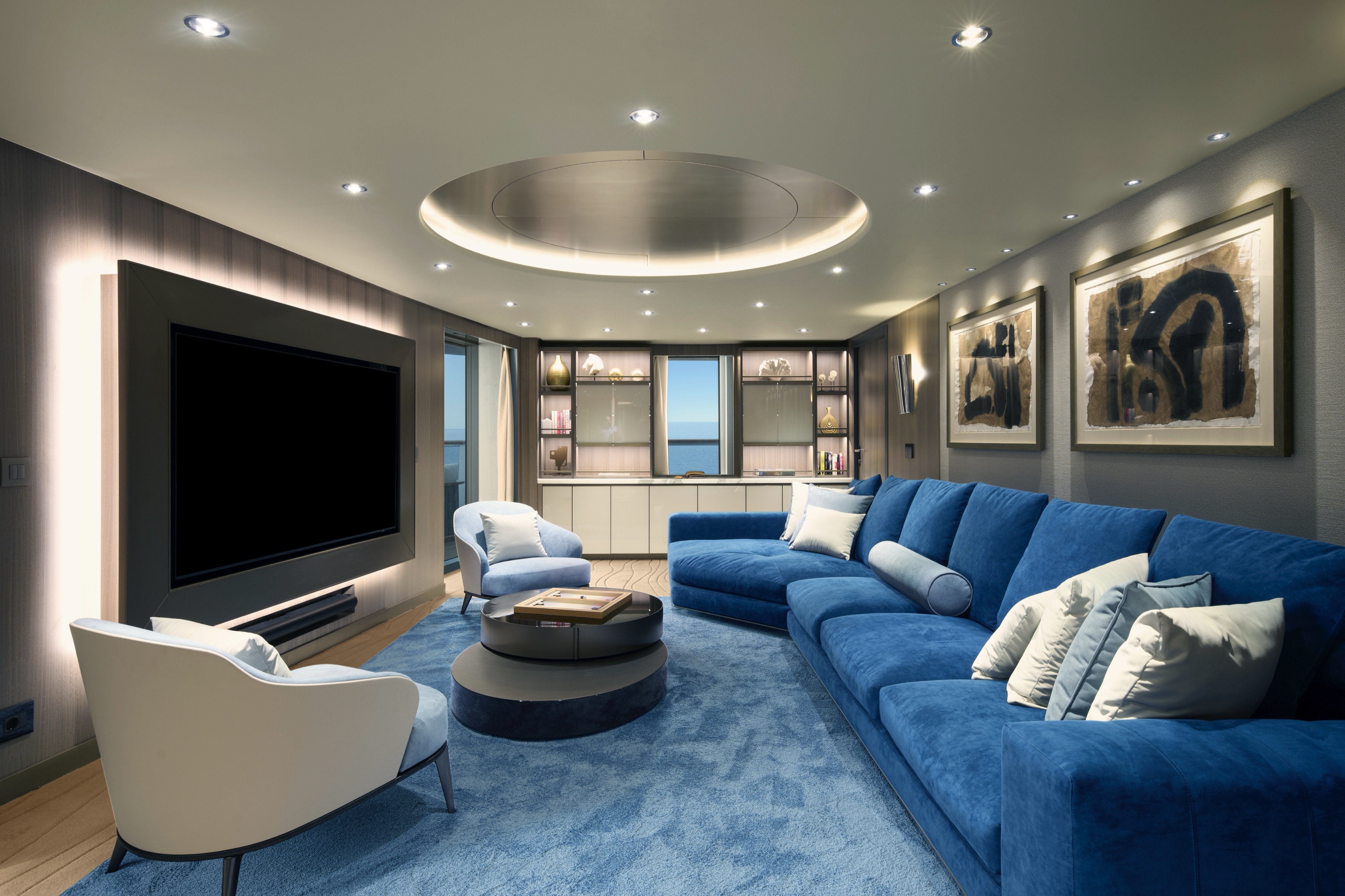
The iconic Owner’s Residence creates the largest living space on-board, with multiple harmonious spaces in which to relax, entertain and unwind.
Stand in awe of the panoramic ocean views from your private outdoor terrace – extending over the full ship’s width – with a spacious infinity whirlpool, and enjoy intuitive, intelligent, dedicated private butler services by the Residence Manager.
Every aspect of the design of our Owner’s Residence reflects the meticulous curation of all details, conscious at all times of our commitment to sustainability.
Features
- Dedicated private butler services by the Residence Manager
- Oversized floor-to-ceiling windows with views of the sea
- Separate living, dining and sleeping areas
- Abundant lounge area
- Dining table for 8 guests
- Spacious work desk area
- In-suite welcome bottle of Dom Pérignon
- Private bar, replenished according to the guests’ preferences
- Espresso machine, kettle and tea pot with a complimentary selection of coffee and teas
- Complimentary personal refillable water bottle for each guest
- Pair of binoculars for guests’ use during their journey
- Technogym Bench and Technogym Case Kit for an efficient in-suite fitness experience
- Laptop-size safe
- Guest lavatory and powder room
- Butler pantry area
Bedroom
- Bespoke king-sized bed sleep system – size: 200 x 200 cm (79 x 79 in)
- Down duvets and pillows
- Fine bed linens
- Extensive pillow selection
- Oversized dressing room
Outdoors
- Panoramic ocean-front terrace covering the full ship’s width, with a private outdoor spacious whirlpool, day beds, a dining table, lounge area, shower and sun loungers
Bathroom
- Luxurious marble double vanity bathroom
- Large bathtub and a walk-in shower
- Private steam room
- Plush bathrobes and bath linens
- Custom bath toiletries and amenities
- Dyson Supersonic TM hairdryer and illuminated make-up/shaving mirror
- Additional guest powder room
Butler Service
- Packing and unpacking to the guests’ preferences
- Pressing and laundering assistance
- Private in-suite dining
- Itinerary and transport planning
- Celebrations planning
- Onboard and ashore reservations assistance
Stats
- Total Suite area: 280 sqm (3,014 sq ft)
- Suite: 155 sqm (1,668 sq ft)
- Terrace: 125 sqm (1,345 sq ft)
- Maximum capacity: 2 adults and 1 child under 2 years old (in a baby cot) A connecting Ocean Terrace suite can be reserved additionally, allowing for a total maximum capacity of 4 adults or 3 adults and 1 child under 18 years old
*All images are a combination of photography and artist renderings.
The artist representations and interior decorations, finishes, and furnishings are provided for illustrative purposes only.

Our luxurious Retreat Residences offer oversized floor-to-ceiling windows leading onto a spacious sun terrace with a private whirlpool, whilst a Residence Host providing butler services is on hand for our guests’ every whim, as well as a dining area for up to four guests, a separate living area and calm workspace.
Features
- Private butler services from our Residence Hosts
- Oversized floor-to-ceiling windows with views of the sea
- Separate living, dining and sleeping areas
- Spacious lounge area
- Dining table for 4 guests
- Spacious work desk area
- In-suite welcome bottle of champagne
- Private refrigerated mini-bar, replenished according to the guests’ preferences from a selection of alcoholic and non-alcoholic beverages
- Cocktail making set
- Espresso machine, kettle and tea pot with a complimentary selection of coffee and teas
- Complimentary personal refillable water bottle for each guest
- Pair of binoculars for guests’ use during their journey
- Technogym Case Kit with a smart range of fitness gear
- Laptop-size safe
Outdoor
- Spacious ocean-front terrace with private outdoor whirlpool and a dining table
Bedroom
- Bespoke king-sized bed sleep system – size: 200 x 200 cm (79 x 79 in)
- Featuring a double sofa bed
- Fine bed linens
- Down duvets and pillows
- Extensive pillow selection
- Oversized walk-in wardrobe with a seated vanity area
Bathroom
- Luxurious marble bathroom with a bathtub, a separate walk-in shower room and heated floors
- Plush bathrobes and bath linens
- Custom bath toiletries and amenities
- Dyson Supersonic TM hairdryer and illuminated make-up/shaving mirror
- Additional guest powder room
Stats
- Total Suite Area: 77 sqm (829 sq ft) on decks 8, 9 / 81 sqm (872 sq ft) on deck 7 Suite: 63 sqm (678 sq ft)
- Terrace: 14 sqm (151 sq ft) on decks 8, 9 / 18 sqm (194 sq ft) on deck 7
- Maximum capacity: 3 adults or 2 adults and 2 children under 18 years old (baby cot or double sofa bed)
*All images are a combination of photography and artist renderings.
The artist representations and interior decorations, finishes, and furnishings are provided for illustrative purposes only.
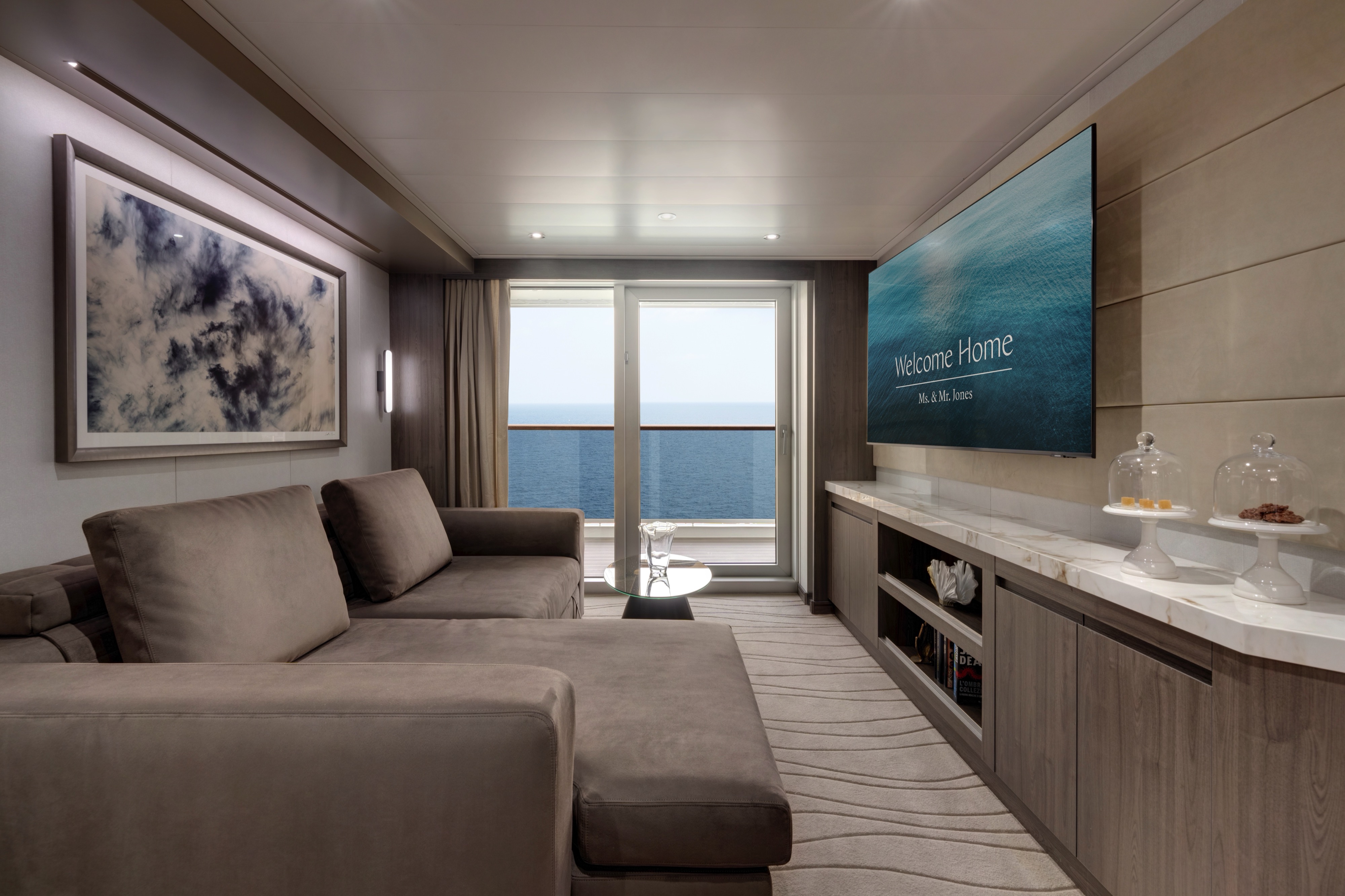
For a true sense of being at home at sea, experience the sweeping decks and effortlessly elegant spaces of the Cove Residences.
Features
- Private butler services from our Residence Hosts
- Oversized floor-to-ceiling windows with views of the sea
- Separate living, dining and sleeping areas
- Spacious lounge area
- Dining table for 4 guests
- Spacious work desk area
- In-suite welcome bottle of champagne
- Private refrigerated mini-bar, replenished according to the guests’ preferences from a selection of alcoholic and non-alcoholic beverages
- Cocktail making set
- Espresso machine, kettle and tea pot with a complimentary selection of coffee and teas
- Complimentary personal refillable water bottle for each guest
- Pair of binoculars for guests’ use during their journey
- Technogym Case Kit with a smart range of fitness gear
- Laptop-size safe
- Smart echnology for light, heating, air conditioning and curtain control
Outdoor
- Spacious ocean-front terrace with private outdoor whirlpool, a dining table and sun loungers or a daybed
Bedroom
- Bespoke king-sized bed sleep system – size: 180 x 200 cm (71 x 79 in)
- Featuring a double sofa bed
- Fine bed linens
- Down duvets and pillows
- Extensive pillow selection
- Spacious walk-in wardrobe with a seated vanity area
Bathroom
- Spacious bathroom with a walk-in shower and heated floors
- Plush bathrobes and bath linens
- Custom bath toiletries and amenities
- Dyson Supersonic TM hairdryer and illuminated make-up/shaving mirror
Stats
- Total Suite Area: 70 sqm (753 sq ft) on decks 7, 8, 9, 10 / 80 sqm (861 sq ft) on deck 6
- Suite: 56 sqm (603 sq ft)
- Terrace: 14 sqm (151 sq ft) on decks 7, 8, 9, 10 / 24 sqm (258 sq ft) on deck 6 Maximum capacity: 3 adults or 2 adults and 2 children under 18 years old (baby cot or double sofa bed)
*All images are a combination of photography and artist renderings.
The artist representations and interior decorations, finishes, and furnishings are provided for illustrative purposes only.
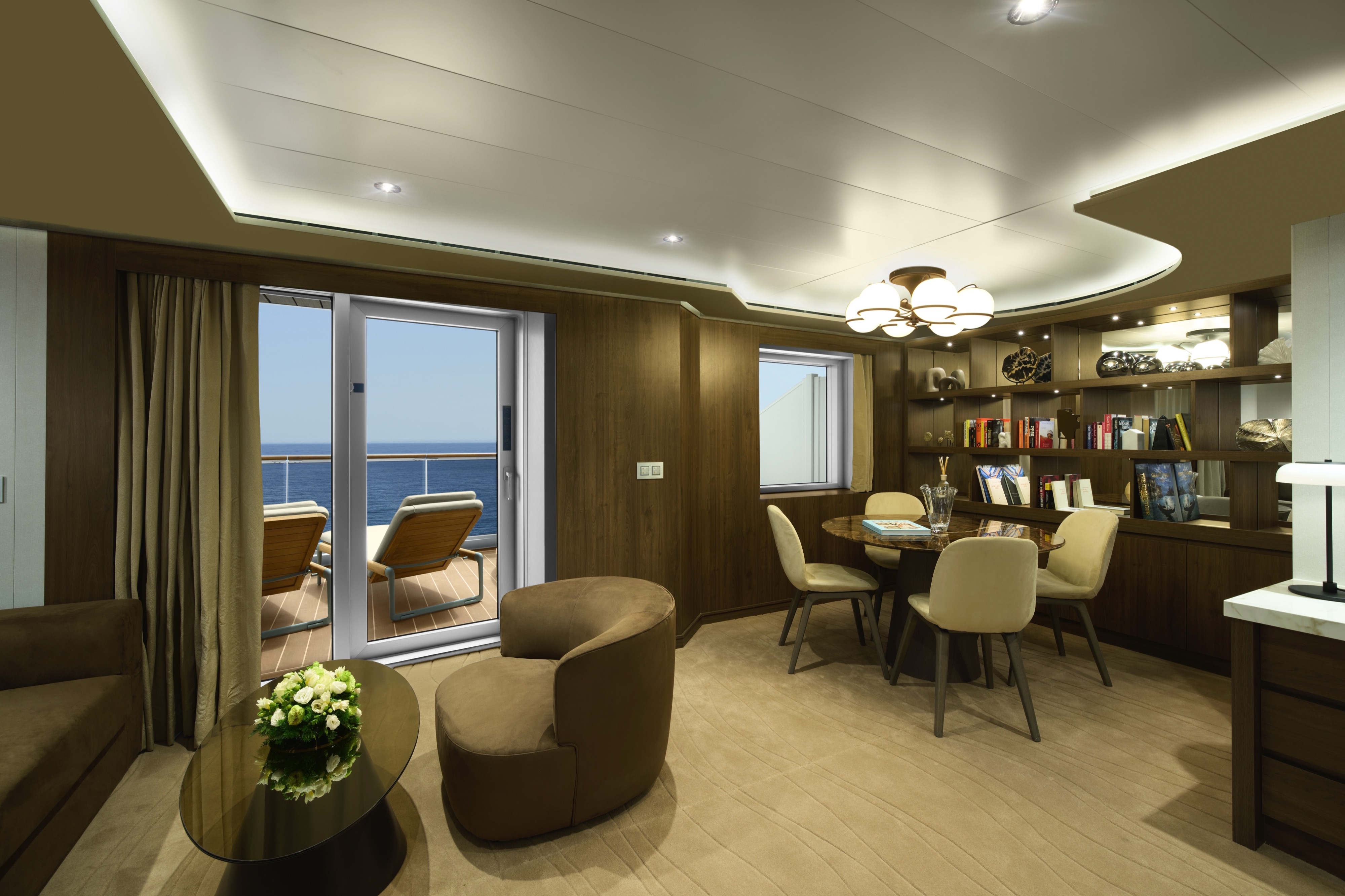
Abundant in space and light, the elegant Serenity Residences offer a large living area, a dining area for six, an adept desk area, a luxurious marble bathroom with a bathtub and separate shower, and a Residence Host providing butler services.
Features
- Private butler services from our Residence Hosts
- Oversized floor-to-ceiling windows with views of the sea
- Separate living, dining and sleeping areas
- Spacious lounge area
- Dining table for 4 guests
- Spacious work desk area
- In-suite welcome bottle of champagne
- Private refrigerated mini-bar, replenished according to the guests’ preferences from a selection of alcoholic and non-alcoholic beverages
- Cocktail making set
- Espresso machine, kettle and tea pot with a complimentary selection of coffee and teas
- Complimentary personal refillable water bottle for each guest
- Pair of binoculars for guests’ use during their journey
- Technogym Bench and Technogym Case Kit for an efficient in-suite fitness experience
- Laptop-size safe
Outdoor
- Panoramic ocean-front terrace with private outdoor whirlpool, a dining table, a daybed and sun loungers
Bedroom
- Bespoke king-sized bed sleep system – size: 180 x 200 cm (71 x 79 in)
- Featuring a double sofa bed
- Fine bed linens
- Down duvets and pillows
- Extensive pillow selection
- Oversized walk-in wardrobe with a seated vanity area
Bathroom
- Luxurious marble bathroom with a bathtub, a separate walk-in shower room and heated floors
- Plush bathrobes and bath linens
- Custom bath toiletries and amenities
- Dyson Supersonic TM hairdryer and illuminated make-up/shaving mirror
Stats
- Total Suite Area: 113 sqm (1,216 sq ft) on deck 7 / 126 sqm (1,356 sq ft) on deck 9
- Suite: 60 sqm (646 sq ft)
- Terrace: 53 sqm (570 sq ft) on deck 7 / 66 sqm (710 sq ft) on deck 9
- Maximum capacity: 3 adults or 2 adults and 2 children under 18 years old (baby cot or double sofa bed)
*All images are a combination of photography and artist renderings.
The artist representations and interior decorations, finishes, and furnishings are provided for illustrative purposes only.
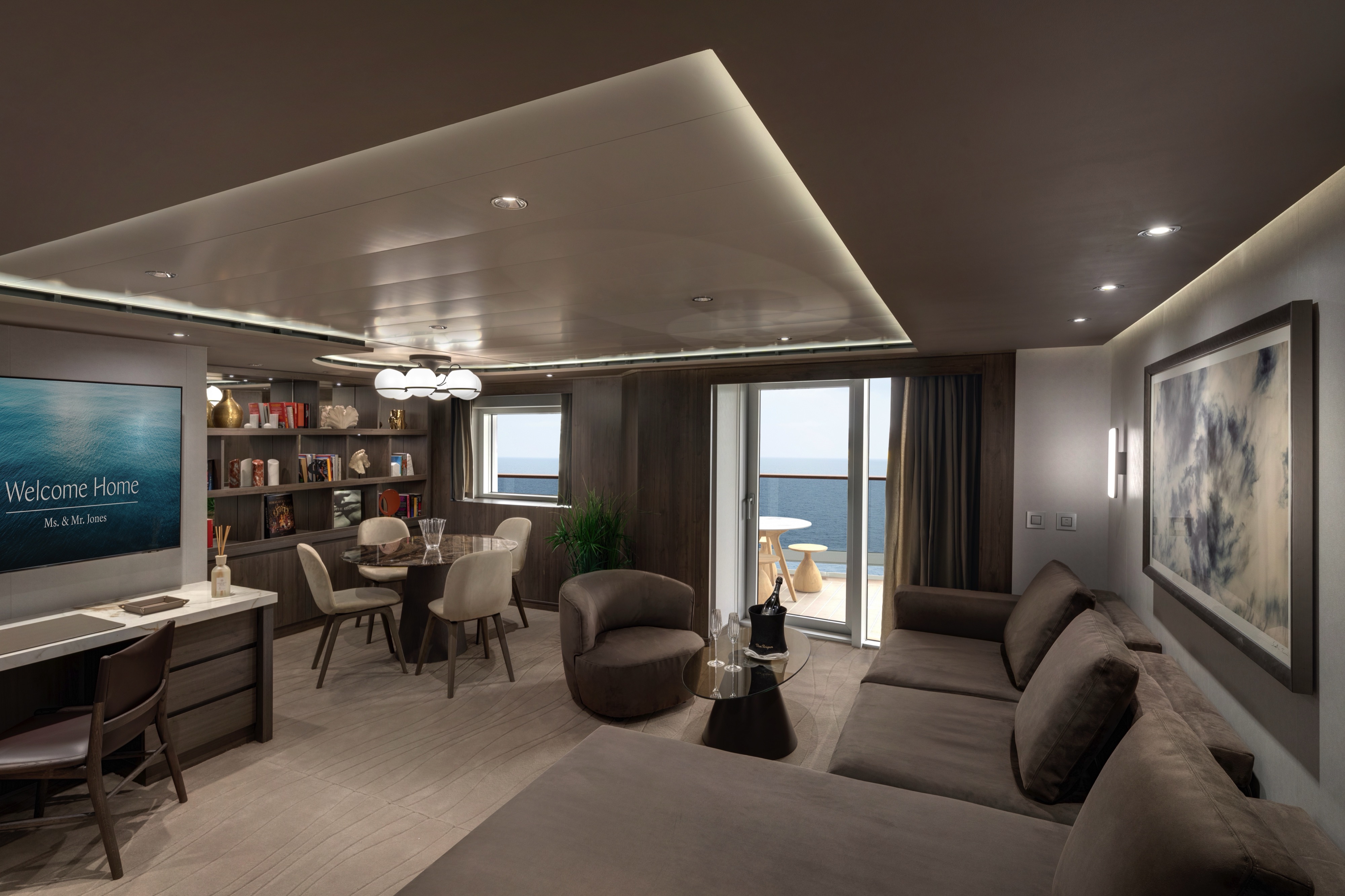
Our Cocoon Residences are amongst the most spacious of our residences, with an expansive sun terrace on the ship’s coveted aft deck.
Features
- Private butler services from our Residence Hosts
- Oversized windows with views of the sea
- Separate living, dining and sleeping areas
- Abundant lounge area
- Dining table for 4 guests
- Spacious work desk area
- In-suite welcome bottle of champagne
- Private refrigerated mini-bar, replenished according to the guests’ preferences from a selection of alcoholic and non-alcoholic beverages
- Cocktail making set
- Espresso machine, kettle and tea pot with a complimentary selection of coffee and teas
- Complimentary personal refillable water bottle for each guest
- Pair of binoculars for guests’ use during their journey
- Technogym Bench and Technogym Case Kit for an efficient in-suite fitness experience
- Laptop-size safe
Outdoor
- Panoramic ocean-front terrace, with private outdoor whirlpool, a dining table, a scenic lounge area and sun loungers
Bedroom
- Bespoke king-sized bed sleep system – size: 200 x 200 cm (79 x 79 in)
- Featuring a double sofa bed
- Fine bed linens
- Down duvets and pillows
- Extensive pillow selection
- Oversized walk-in wardrobe with a seated vanity area
Bathroom
- Luxurious marble bathroom with a bathtub, a separate walk-in shower room and heated floors
- Plush bathrobes and bath linens
- Custom bath toiletries and amenities
- Dyson Supersonic TM hairdryer and illuminated make-up/shaving mirror
- Additional guest powder room
Stats
- Total Suite Area: 149 sqm (1,604 sq ft)
- Suite: 74 sqm (797 sq ft)
- Terrace: 75 sqm (807 sq ft)
- Maximum capacity: 3 adults or 2 adults and 2 children under 18 years old (baby cot or double sofa bed)
*All images are a combination of photography and artist renderings.
The artist representations and interior decorations, finishes, and furnishings are provided for illustrative purposes only.
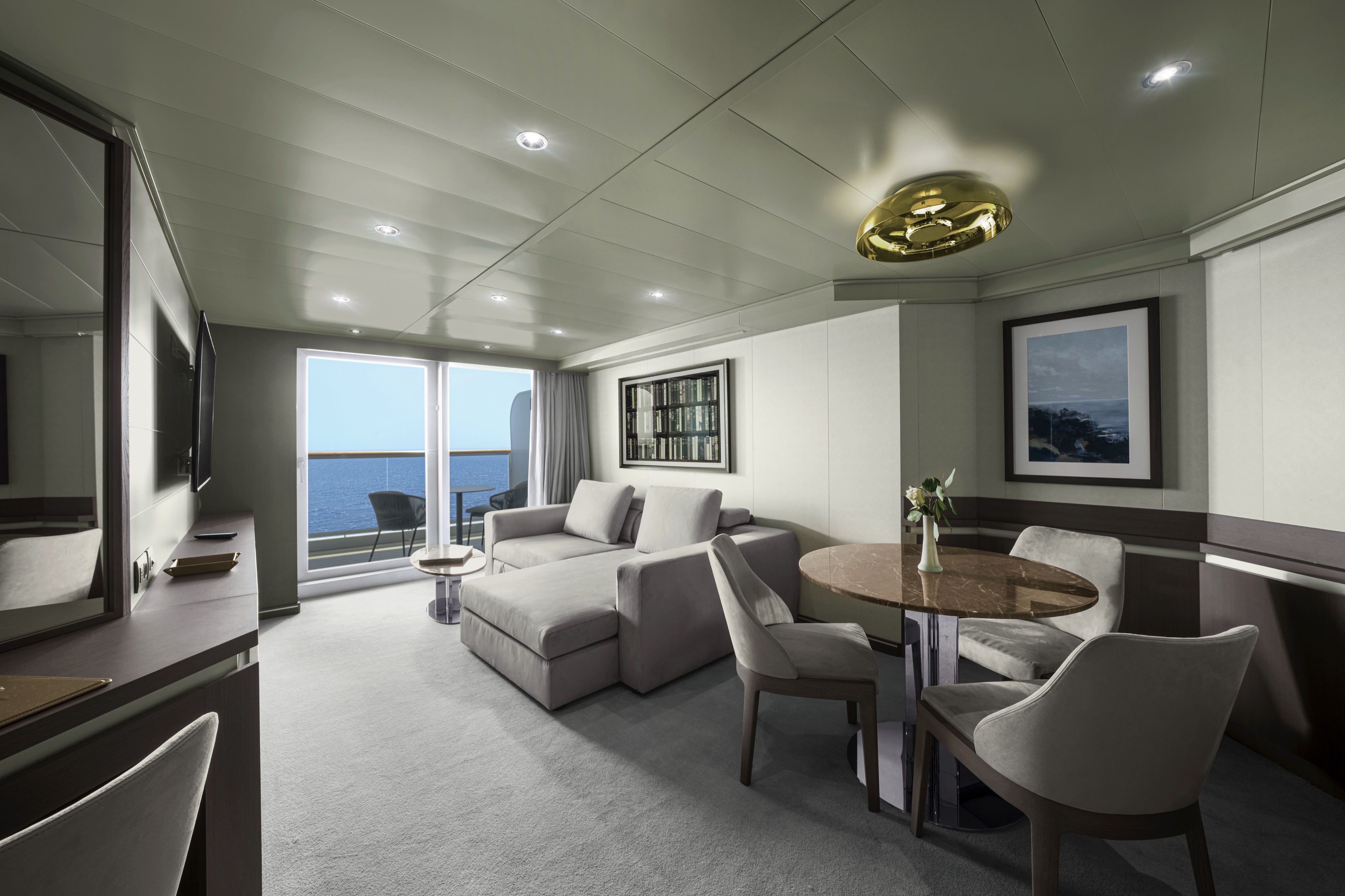
The most spacious of our penthouses, the Grand Penthouses offer elegant spaces with a separate stylish living area, a neat work space and a separate dining area for four, whilst the private sun terraces allow guests to unwind and savour the ocean, in the company of friends or one another.
Features
- Oversized floor-to-ceiling windows with views of the sea
- Separate living, dining and sleeping areas
- Spacious lounge area
- Dining table for 4 guests
- Spacious work desk area
- In-suite welcome bottle of champagne
- Private refrigerated mini-bar, replenished according to the guests’ preferences from a selection of alcoholic and non-alcoholic beverages
- Espresso machine, kettle and tea pot with a complimentary selection of coffee and teas
- Complimentary personal refillable water bottle for each guest
- Pair of binoculars for guests’ use during their journey
- Technogym Case Kit with a smart range of fitness gear
- Safe accommodating most tablets and laptops
Outdoor
- Spacious ocean-front terrace with a dining area
- Comfortable daybed for relaxation
Bedroom
- Bespoke king-sized bed sleep system – size: 180 x 200 cm (71 x 79 in)
- Featuring a double sofa bed
- Fine bed linens
- Down duvets and pillows
- Extensive pillow selection
- Spacious walk-in wardrobe with a seated vanity area
Bathroom
- Spacious bathroom with a walk-in shower and heated floors
- Plush bathrobes and bath linens
- Custom bath toiletries and amenities
- Dyson Supersonic TM hairdryer and illuminated make-up/shaving mirror
Stats
- Total Suite Area: 60 sqm (646 sq ft) on decks 7, 8, 9, 10 / 68 sqm (732 sq ft) on deck 6
- Suite: 47 sqm (506 sq ft)
- Terrace: 13 sqm (140 sq ft) on decks 7, 8, 9, 10 / 21 sqm (226 sq ft) on deck 6
- Maximum capacity: 3 adults or 2 adults and 2 children under 18 years old (baby cot or double sofa bed)
*All images are a combination of photography and artist renderings.
The artist representations and interior decorations, finishes, and furnishings are provided for illustrative purposes only.
Some suites feature bathtubs and accessible facilities:
Grand Penthouse Accessibility Features
- Roll-in shower with grab-bar and fold-down seat (height of seat from the floor is 450 mm / 17.7 in)
- Grab-bar next to the toilet seat
- Portable toilet seat risers available onboard
- Hand-held shower wand
- Lowered towel racks
- Accessibility equipment for hearing impaired (Assistive Listening System (ALS) and/or TTY devices)
- Lowered wardrobe bars and shelving
- Lowered safe
- Double peephole on entrance door
- All doorways are wheelchair accessible
- Entrance door width 900 mm (31.5 in)
- Bathroom door width 900 mm (31.5 in)
Accessible Grand Penthouse Stats
- Deck: 9 – Middle, close to lifts
- Number of Suites: 1 Total
- Suite Area: 60 sqm – 646 sq ft
- Suite: 47 sqm – 506 sq ft
- Terrace: 13 sqm – 140 sq ft
*Features may vary by suite.
Please inform your Travel Advisor or the Explora Experience Centre Ambassador of your requirements when reserving your journey.
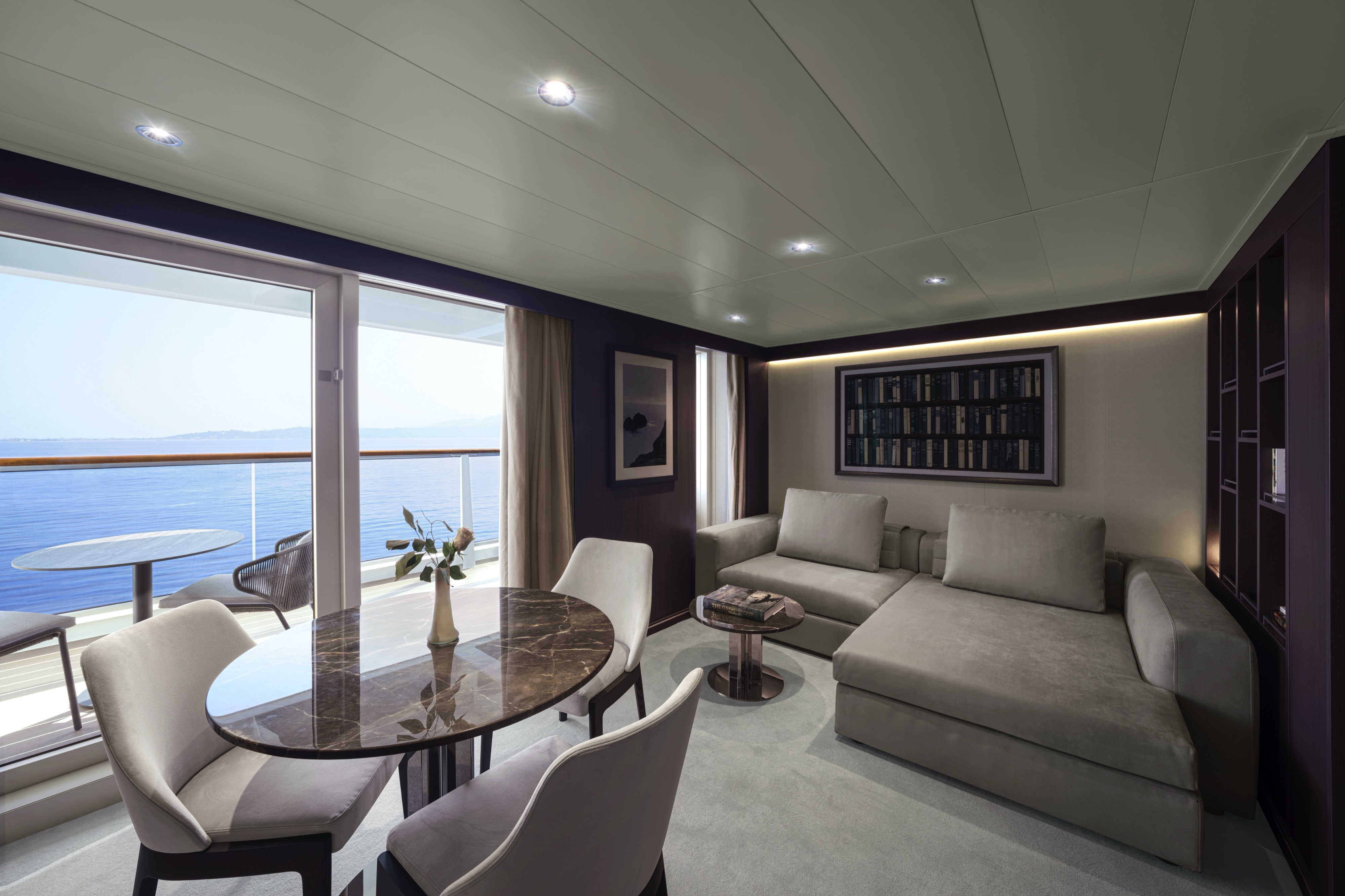
These light-filled, luxurious Premier Penthouses are designed for withdrawing in style or entertaining other guests – at a dining table laid for four, in the stylish living area and on the private sun terrace with a second seating area and daybeds or sunbeds overlooking the ocean.
Features
- Oversized floor-to-ceiling windows with views of the sea
- Separate living, dining and sleeping areas
- Spacious lounge area
- Dining table for 4 guests
- In-suite welcome bottle of champagne
- Private refrigerated mini-bar, replenished according to the guests’ preferences from a selection of alcoholic and non-alcoholic beverages
- Espresso machine, kettle and tea pot with a complimentary selection of coffee and teas
- Complimentary personal refillable water bottle for each guest
- Pair of binoculars for guests’ use during their journey
- Technogym Case Kit with a smart range of fitness gear
- Safe accommodating most tablets and laptops
Outdoor
- Spacious ocean-front terrace with a dining area
- Comfortable daybed for relaxation
Bedroom
- Bespoke king-sized bed sleep system – size: 180 x 200 cm (71 x 79 in)
- Some suites feature a double sofa bed
- Down duvets and pillows
- Fine bed linens
- Extensive pillow selection
- Spacious walk-in wardrobe with a seated vanity area
Bathroom
- Spacious bathroom with a walk-in shower and heated floors
- Plush bathrobes and bath linens
- Custom bath toiletries and amenities
- Dyson Supersonic TM hairdryer and illuminated make-up/shaving mirror
Stats
- Total Suite Area: 52 sqm (560 sq ft)
- Suite: 42 sqm (452 sq ft)
- Terrace: 10 sqm (108 sq ft)
- Maximum capacity: 3 adults or 2 adults and 1 child under 18 years old (baby cot, double sofa bed or rollaway bed)
*All images are a combination of photography and artist renderings.
The artist representations and interior decorations, finishes, and furnishings are provided for illustrative purposes only.

Flooded with light from the floor-to-ceiling oversized windows, the Deluxe Penthouses offer elegant accommodation and a stylish living area, a neat work space and a separate dining area for four.
Features
- Oversized floor-to-ceiling windows with views of the sea
- Spacious lounge area
- Dining table for 4 guests
- Some suites feature a spacious work desk area
- In-suite welcome bottle of champagne
- Private refrigerated mini-bar, replenished according to the guests’ preferences from a selection of alcoholic and non-alcoholic beverages
- Espresso machine, kettle and tea pot with a complimentary selection of coffee and teas
- Complimentary personal refillable water bottle for each guest
- Pair of binoculars for guests’ use during their journey
- Technogym Case Kit with a smart range of fitness gear
- Safe accommodating most tablets and laptops
Outdoor
- Spacious ocean-front terrace with a dining area
- Comfortable daybed or lounge chairs for relaxation
Bedroom
- Bespoke king-sized bed sleep system – size: 180 x 200 cm (71 x 79 in)
- Down duvets and pillows
- Fine bed linens
- Extensive pillow selection
- Spacious walk-in wardrobe with a seated vanity area
Bathroom
- Spacious bathroom with a walk-in shower and heated floors
- Plush bathrobes and bath linens
- Custom bath toiletries and amenities
- Dyson Supersonic TM hairdryer and illuminated make-up/shaving mirror
* Some suites feature bathtubs
Stats
- Total Suite Area: 48 sqm (517 sq ft) on decks 9, 10 / 53 sqm (570 sq ft) on deck 6 / 61 sqm (657 sq ft) on deck 7
- Suite: 38 sqm (409 sq ft) on decks 9, 10 / 43 sqm (463 sq ft) on decks 6, 7
- Terrace: 10 sqm (108 sq ft) on decks 6, 9, 10 / 18 sqm (194 sq ft) on deck 7
- Maximum capacity: 3 adults or 2 adults and 1 child under 18 years old (baby cot, double sofa bed or rollaway bed)
*All images are a combination of photography and artist renderings.
The artist representations and interior decorations, finishes, and furnishings are provided for illustrative purposes only.
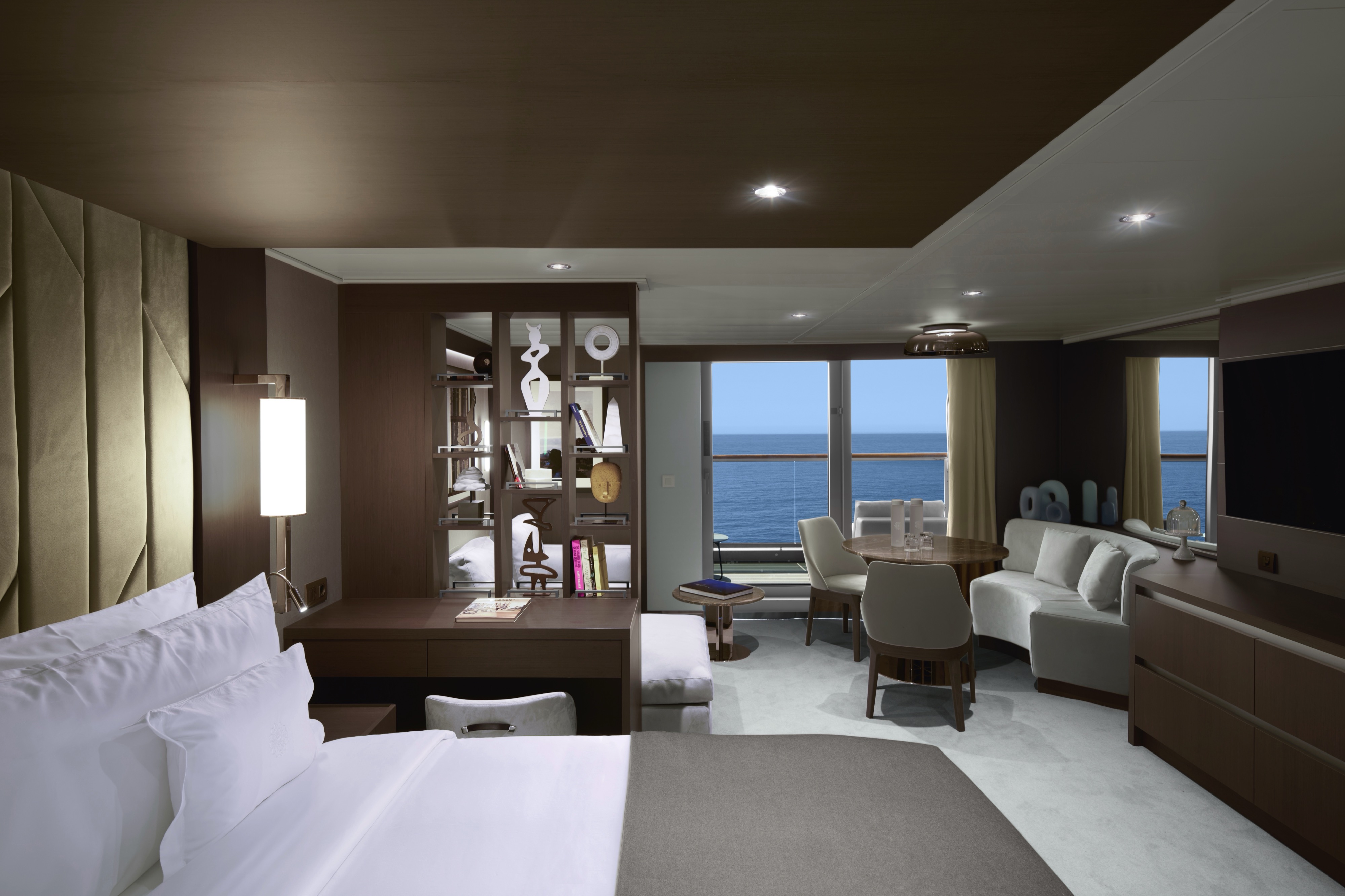
Each of our Penthouses offers a spacious living area, a neat work space and a separate dining area for four, allowing guests to entertain others or retreat in style as they see fit.
Features
- Oversized floor-to-ceiling windows with views of the sea
- Spacious lounge area
- Dining table for 4 guests
- In-suite welcome bottle of champagne
- Private refrigerated mini-bar, replenished according to the guests’ preferences from a selection of alcoholic and non-alcoholic beverages
- Espresso machine, kettle and tea pot with a complimentary selection of coffee and teas
- Complimentary personal refillable water bottle for each guest
- Pair of binoculars for guests’ use during their journey
- Technogym Case Kit with a smart range of fitness gear
- Safe accommodating most tablets and laptops
Outdoor
- Spacious ocean-front terrace with a dining area
- Comfortable daybed for relaxation
Bedroom
- Bespoke king-sized bed sleep system – size: 180 x 200 cm (71 x 79 in)
- Down duvets and pillows
- Fine bed linens
- Extensive pillow selection
- Spacious walk-in wardrobe with a seated vanity area
Bathroom
- Spacious bathroom with a walk-in shower and heated floors
- Plush bathrobes and bath linens
- Custom bath toiletries and amenities
- Dyson Supersonic TM hairdryer and illuminated make-up/shaving mirror
Stats
- Total Suite Area: 43 sqm (463 sq ft) on decks 7, 8, 9 / 48 sqm (517 sq ft) on deck 6
- Suite: 34 sqm (366 sq ft)
- Terrace: 9 sqm (97 sq ft) on decks 7, 8, 9 / 14 sqm (151 sq ft) on deck 6
- Maximum capacity: 3 adults or 2 adults and 1 child under 18 years old (baby cot, double sofa bed or rollaway bed)
*All images are a combination of photography and artist renderings.
The artist representations and interior decorations, finishes, and furnishings are provided for illustrative purposes only.

Our Ocean Grand Terrace Suites offer a more spacious private sun terrace, allowing guests to savour the ocean from the comfort of their daybed.
Features
- Oversized floor-to-ceiling windows with views of the sea
- Lounge area with coffee/dining table
- In-suite welcome bottle of champagne
- Private refrigerated mini-bar, replenished according to the guests’ preferences from a selection of alcoholic and non-alcoholic beverages
- Espresso machine, kettle and tea pot with a complimentary selection of coffee and teas
- Complimentary personal refillable water bottle for each guest
- Pair of binoculars for guests’ use during their journey
- Safe accommodating most tablets and laptops
Outdoor
- Spacious ocean-front terrace with a dining area
- Comfortable daybed for relaxation
Bedroom
- Bespoke king-sized bed sleep system – size: 180 x 200 cm (71 x 79 in). Some suites with twin beds – size: 2 x 90 x 200 cm (35 x 79 in)
- Down duvets and pillows
- Fine bed linens
- Extensive pillow selection
- Spacious walk-in wardrobe with a seated vanity area
Bathroom
- Spacious bathroom with a walk-in shower and heated floors
- Plush bathrobes and bath linens
- Custom bath toiletries and amenities
- Dyson Supersonic TM hairdryer and illuminated make-up/shaving mirror
Stats
- Total Suite area: 39 sqm (420 sq ft)
- Suite: 28 sqm (301 sq ft)
- Bathroom: 4 sqm (43 sq ft)
- Terrace: 11 sqm (118 sq ft)
- Maximum capacity: 2 adults and 1 child under 18 years old (baby cot or rollaway bed) Decks: 6, 7 – Aft, Middle and Forward Number of suites: 70
*All images are a combination of photography and artist renderings.
The artist representations and interior decorations, finishes, and furnishings are provided for illustrative purposes only.
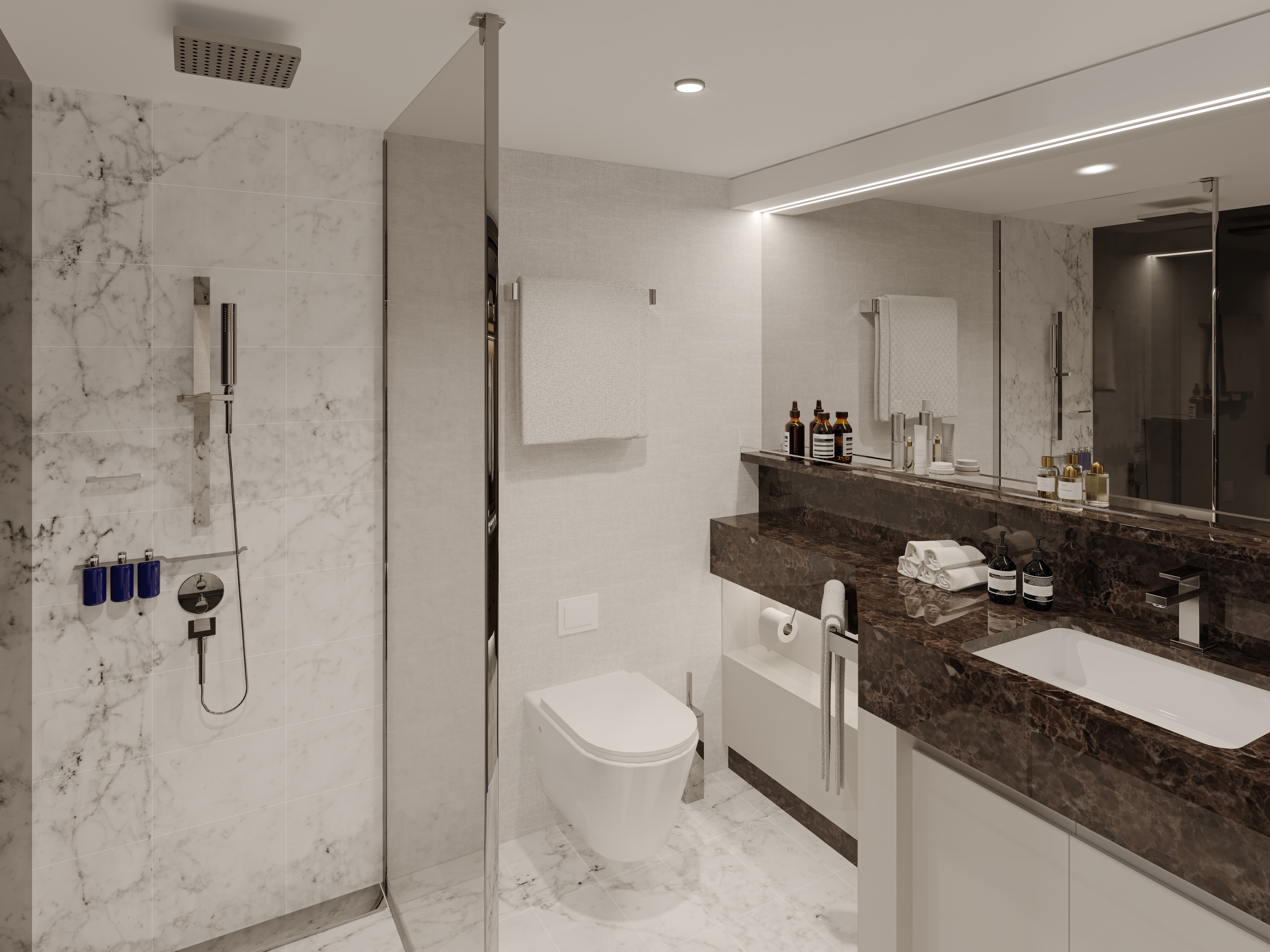
Our Ocean Terrace Suites elegantly combine space and light.
Features
- Oversized floor-to-ceiling windows with views of the sea
- Lounge area with coffee/dining table
- In-suite welcome bottle of champagne
- Private refrigerated mini-bar, replenished according to the guests’ preferences from a selection of alcoholic and non-alcoholic beverages
- Espresso machine, kettle and tea pot with a complimentary selection of coffee and teas
- Complimentary personal refillable water bottle for each guest
- Pair of binoculars for guests’ use during their journey
- Safe accommodating most tablets and laptops
Outdoor
- Spacious ocean-front terrace with a dining area
- Comfortable daybed for relaxation
Bedroom
- Bespoke king-sized bed sleep system – size: 180 x 200 cm (71 x 79 in). Some suites with twin beds – size: 2 x 90 x 200 cm (35 x 79 in)
- Down duvets and pillows
- Fine bed linens
- Extensive pillow selection
- Spacious walk-in wardrobe with a seated vanity area
Bathroom
- Spacious bathroom with a walk-in shower and heated floors
- Plush bathrobes and bath linens
- Custom bath toiletries and amenities
- Dyson Supersonic TM hairdryer and illuminated make-up/shaving mirror
Stats
- Total Suite area: 35 sqm (377 sq ft)
- Suite: 28 sqm (301 sq ft)
- Bathroom: 4 sqm (43 sq ft)
- Terrace: 7 sqm (75 sq ft)
- Maximum capacity: 2 adults and 1 child under 18 years old (baby cot or rollaway bed)
*All images are a combination of photography and artist renderings.
The artist representations and interior decorations, finishes, and furnishings are provided for illustrative purposes only.
Some suites feature bathtubs and accessible facilities:
Ocean Terrace Suite Accessibility Features
- Roll-in shower with grab-bar and fold-down seat (height of seat from the floor is 450 mm / 17.7 in)
- Grab-bar next to the toilet seat
- Portable toilet seat risers available onboard
- Hand-held shower wand
- Lowered towel racks
- Accessibility equipment for hearing impaired (Assistive Listening System (ALS) and/or TTY devices)
- Lowered wardrobe bars and shelving
- Lowered safe
- Double peephole on entrance door
- All doorways are wheelchair accessible
- Entrance door width 900 mm (31.5 in)
- Bathroom door width 900 mm (31.5 in)
Stats
- Deck 8, 9, 10 – Forward, close to lifts
- Number of Suites OT2 – 4, OT3 – 4, OT4 – 1
- Total Suite Area: 49 sqm – 526 sq ft
- Suite: 39 sqm – 419 sq ft
- Terrace: 10 sqm – 107 sq ft
*Features may vary by suite.
Please inform your Travel Advisor or the Explora Experience Centre Ambassador of your requirements when reserving your journey.
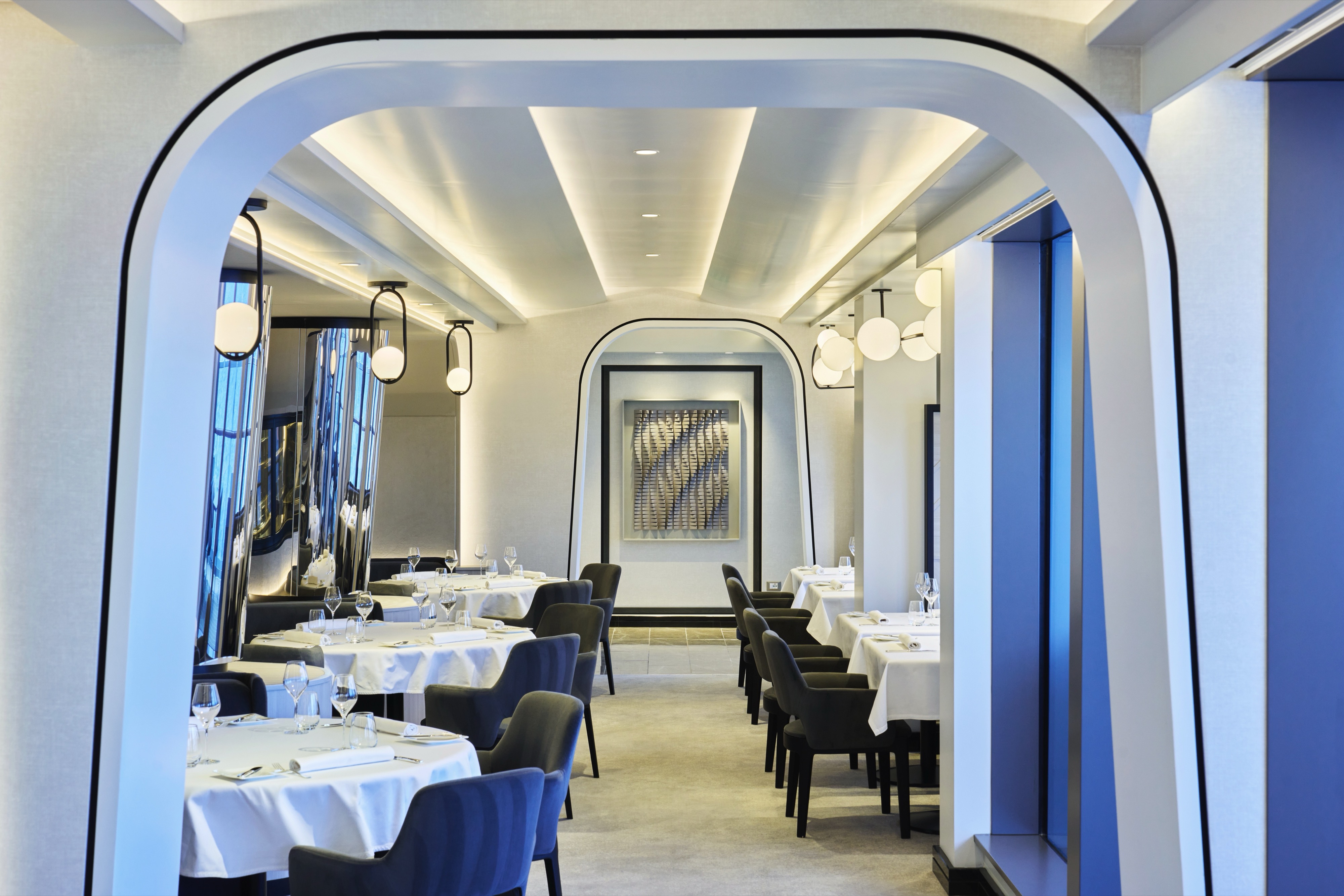
A Gastronomic Adventure
As our signature fine-dining experience, Anthology elevates Italian cuisine, offering an unparalleled gastronomic adventure.
On the menu, created by our esteemed Head of Culinary, Franck Garanger, each dish is a celebration of Italy’s finest regional ingredients and flavours.
From the renowned flavours of Piedmont’s truffle-rich countryside in the North, to the famed specialities of Italy’s South, each plate celebrates the local produce and time-honoured techniques of every region in Italy.
The menu is an ingenious display of creativity – a vibrant tapestry of regional flavours and authentic ingredients which invites guests to immerse themselves in the different styles and tastes of Italy’s universally loved cuisine.
Contemporary, Refined Elegance
With the opportunity to dine outdoors, Anthology offers an intimate yet elevated dining atmosphere with flawless, attentive service.
- Indoor seating: 48
- Outdoor seating: 22
- Open for dinner
- Reservations recommended
- An Exclusive Experience Fee Applies
- Located on Deck 5
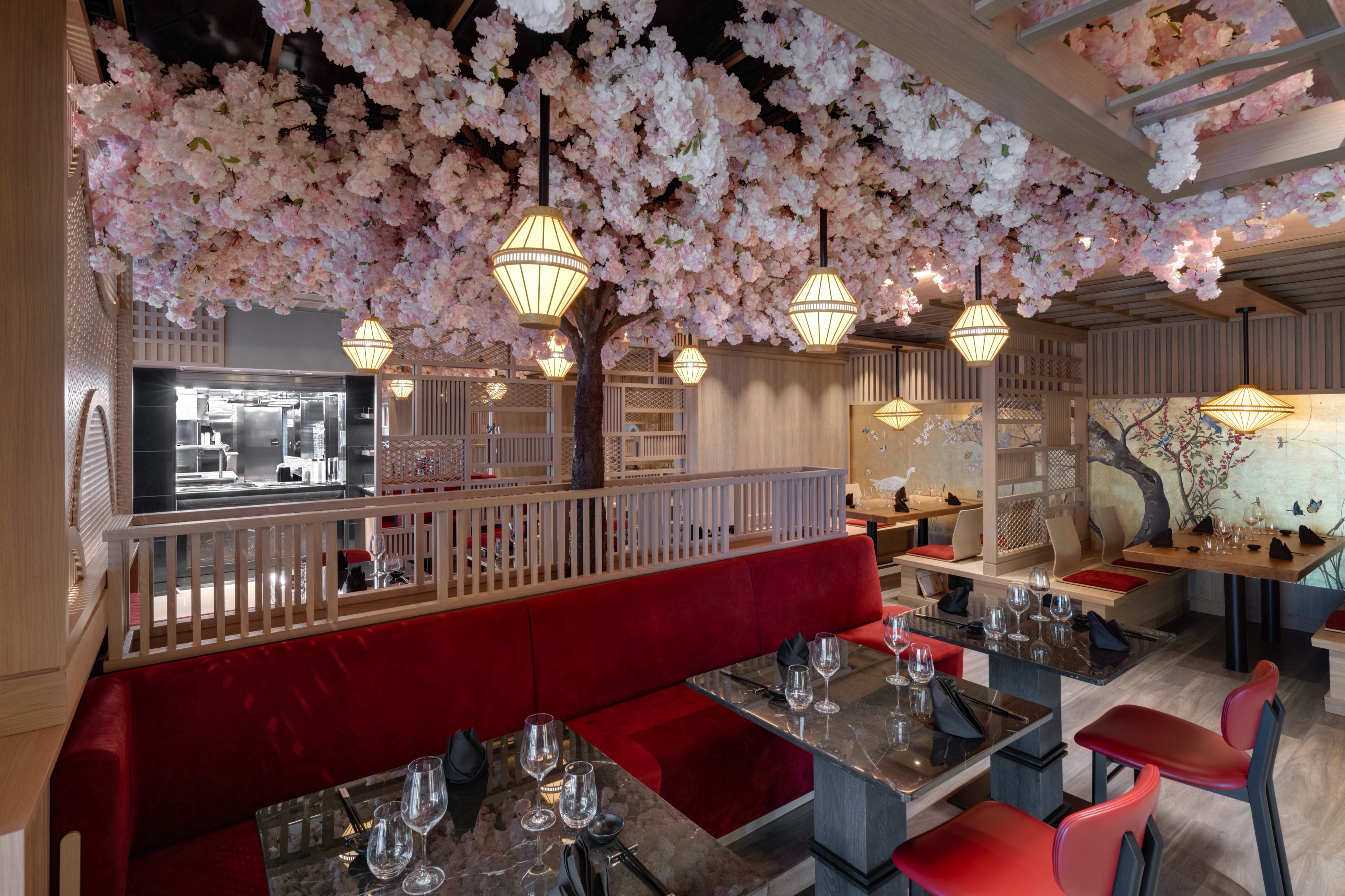
An immersive, authentic dining experience offering the finest Pan-Asian cuisine.
Named after the cherry blossom – the national flower of Japan – and symbolic of renewal and optimism, Sakura offers Japanese, Thai, Vietnamese, and Malaysian flavours for a taste of Pan-Asian cuisine that is both authentic and energising.
The space takes inspiration from Japan’s rich cultural heritage of tradition and rituals blended with distinct Japanese design cues, to create an intimate and welcoming space. The ancient tea rooms of Kyoto provide the inspiration for Sakura, where dark wood frames lead your eye to traditional Japanese ceiling details, adorned with a cherry blossom tree canopy which shrouds diners with a warm atmosphere of festoon lights.
Authenticity extends to the kitchen, where chefs follow traditional techniques – using only the very best carefully sourced ingredients – to ensure a truly pan-Asian experience.
Expansive ocean views, a Sake sommelier, Asian-influenced beverages – including a curated selection of sakes and shōchū – combined with seamless service and modern Asian music create a dynamic dining experience.
Signature Dishes at Sakura
Wagyu beef tataki, wakame salad, smoked Madagascan pepper
Never cooked or grilled, our sustainably sourced prime grade 5 Japanese wagyu beef is delicately torched by our chefs: this authentic method of cooking ensures that the best qualities of the beef are preserved for the guests’ mouth-watering enjoyment.
Makrut lime pavlova, mango brunoise, passion fruit, mango sorbet
A fusion of east and west, this unique interpretation of pavlova is a perfect representation of the passionate, creative expertise and multicultural diversity of our talented pastry team .
Kale salad
Another example of our chefs’ ingenuity, a humble kale salad is transformed into culinary art for our guests to enjoy. This superfood salad is not simply dressed, but cured with the finest quality of sesame dressing for a rounded flavour – it represents a fusion of clean living with the flavours of Asia.
- Indoor seating: 92
- Outdoor seating: 26
- Open for lunch and dinner
- Reservations recommended
- The Sushi Bar is open-seating on a first come first served basis.
- Located on Deck 5
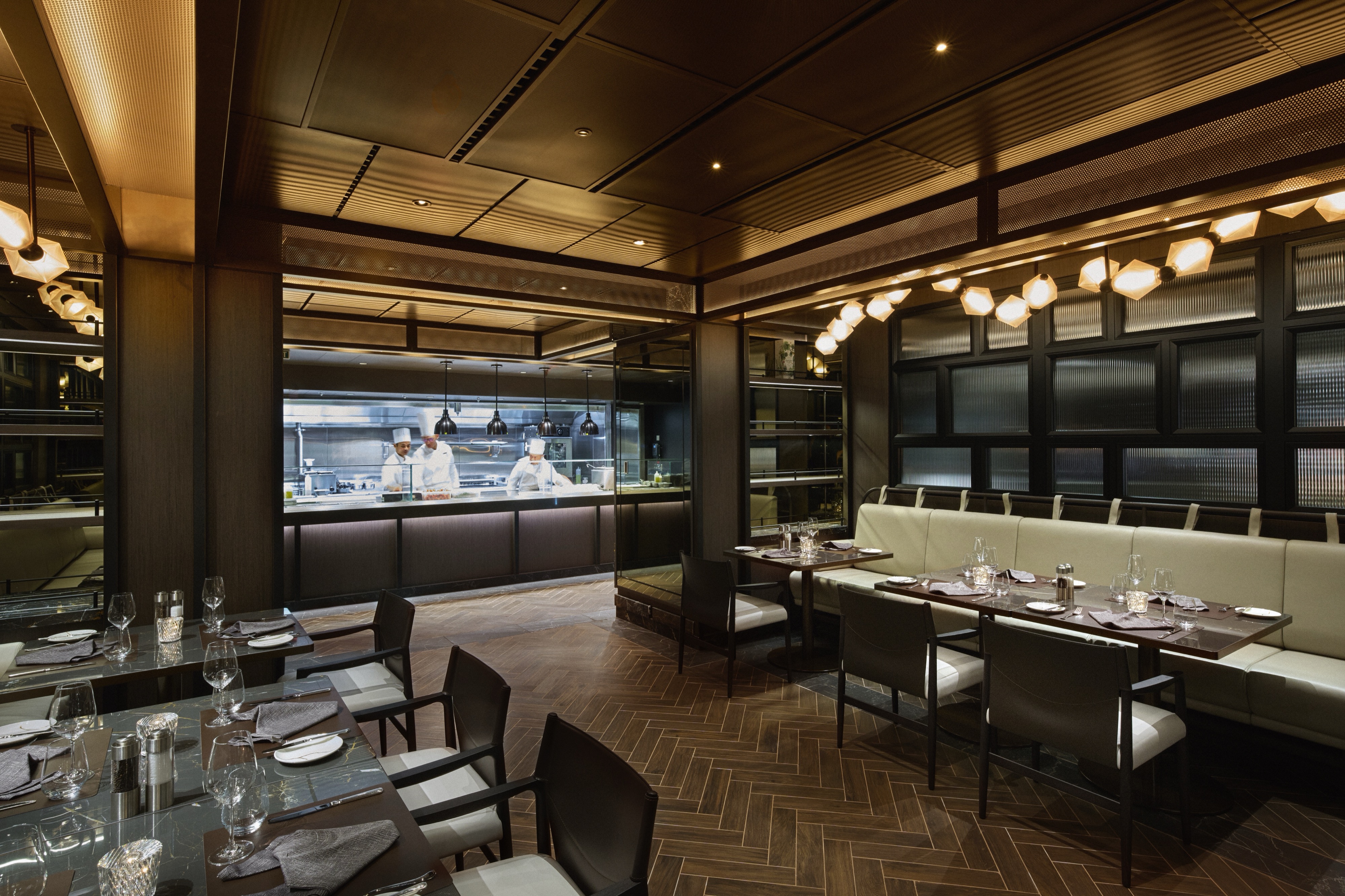
Inspired by the marbling found in only the finest beef, Marble & Co. Grill serves exceptional cuts, personally sourced and sustainably farmed.
The menu has been designed to take guests on a journey of discovery, with sumptuous, rare meats sourced for their flavour and distinctive provenance. More than a steakhouse, Marble & Co is the realisation of a vision where careful attention to ingredients and passion for cooking come together to create a truly special dining experience.
This redefined European steakhouse experience is reflected through the modern, understated yet sophisticated design with soft lighting and relaxed, attentive service. The experience is augmented by an in-house dry ager and a cellar boasting a superb selection of fine wines.
Signature Dishes at Marble & Co. Grill
Grilled prime rib, aged 30-days, cherry tomatoes, Hollandaise sauce
Provenance and quality take centre stage, to create the finest version of a steakhouse classic. From a local producer in Deux Sévres region of the lush Loire Valleé, it’s clear why the famous Jersiaise breed, renowned for its sensational flavour and intense marbling, is one of the most sought-after cuts or prime rib. To truly appreciate this beautiful cut, it is topped simply with cherry tomatoes and a sumptuous Hollandaise sauce.
Crushed fingerling potatoes, Le Beurre Bordier butter from Normandy, Calvisius Oscietra caviar, crème fraîche, chives
A simple dish executed with the finest ingredients. The crushed fingerling potatoes are made with Bordier butter, arguably, the finest butter in the world, served only in the finest establishments. Potatoes are topped with Calvisius Oscietra caviar, known the world over for being some of the best quality caviar available; the caviar is sustainably produced in Italy, in an area rich with fresh spring water, contributing to its high quality and low-salt flavour.
- Indoor seating: 80
- Outdoor seating: 10
- Open for dinner
- Reservations recommended
- Located on Deck 5
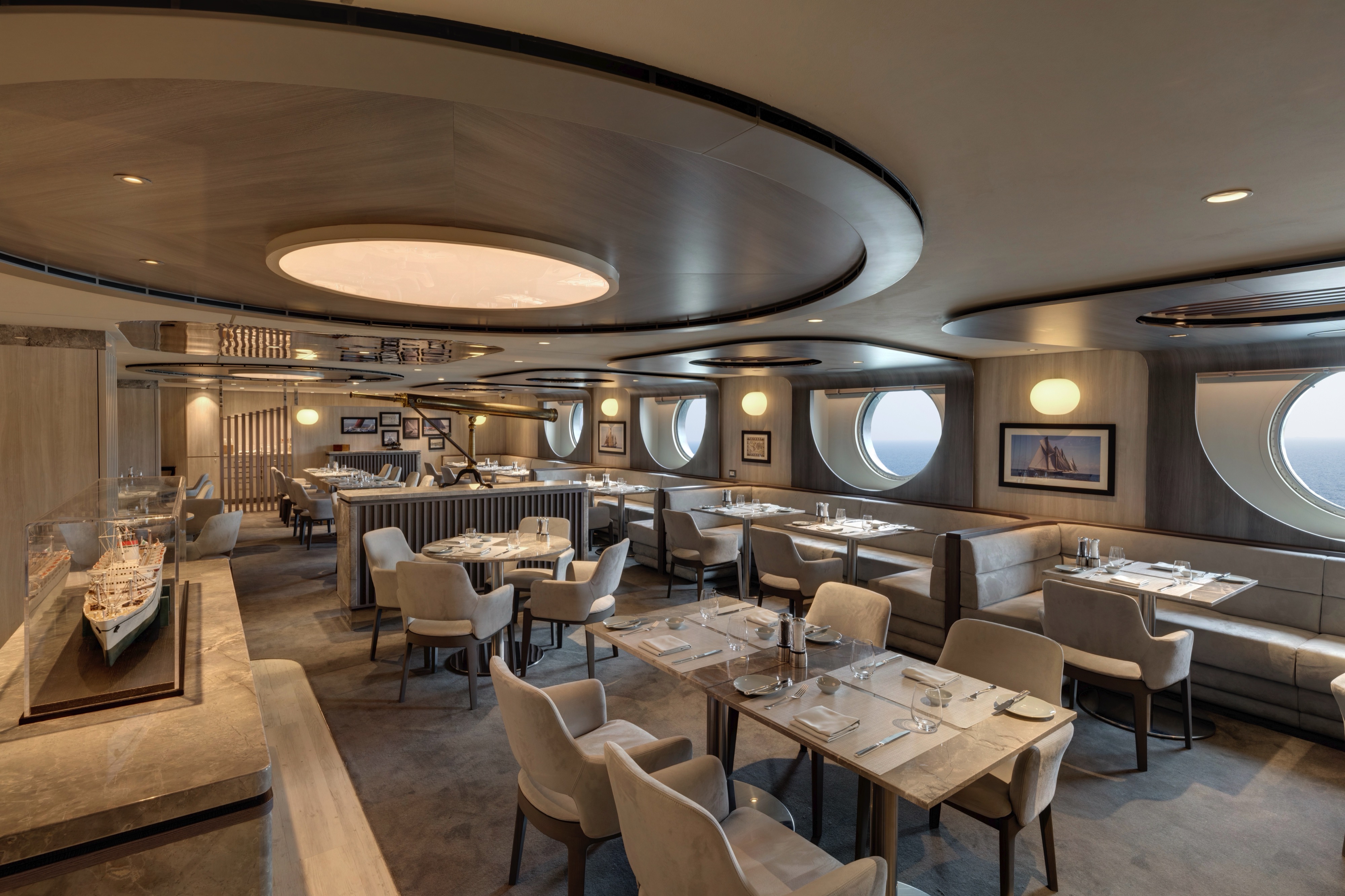
A relaxed celebration of the flavours, ambience and la dolce vita of the Mediterranean.
Inspired by sailings across crystal clear waters, the Med Yacht Club is influenced by sophisticated, beachside Mediterranean restaurants, embracing the varied cuisines of the region.
Effortlessly refined in its design, Med Yacht Club creates a relaxed, convivial atmosphere, where bright sunshine streaming through large portholes and Med-influenced music transport guests on a culinary journey inspired by sea travel.
Inspired by authentic Mediterranean dining, and infusing tastes and textures of Italy, Spain, Greece, France, and North Africa – while incorporating plant-based, vegetarian and wholesome ingredients – the menu of Med Yacht Club serves sharing plates, created with passion, for guests to enjoy with friends and family alike. Each dish is inspired by the most authentic of Mediterranean ingredients and flavours.
Wines will showcase the rich vineyards of the Mediterranean, with fresh juices and cocktails honouring regional ingredients.
Signature Dishes at Med Yacht Club
Grilled octopus, San Marzano tomato sauce, Taggiasca olives, green beans, parsley
If ever there were a singular dish to represent the importance province plays in the ingredients used onboard Explora Journeys, then this is surely it. Sharp sundried Taggiasca olives compliment the sweet San Marzano tomatoes, creating a perfectly balanced bed for the expertly grilled, sustainably sourced octopus.
Sweet caprese with cherry tomatoes, strawberries, burrata, pesto
A true representation of the creativity and skill of our chefs, this sweet interpretation of an Italian classic will surprise and delight in equal measure. The finest cherry tomatoes and strawberries create an intriguing base, upon which our burrata sits – made with emulsified burrata cream, and adorned with even more sweet tomatoes and strawberries with a drizzle of pesto from Sicilian Bronte pistachios.
- Indoor seating: 136 (34 at the bar)
- Open for lunch and dinner
- Located on Deck 4
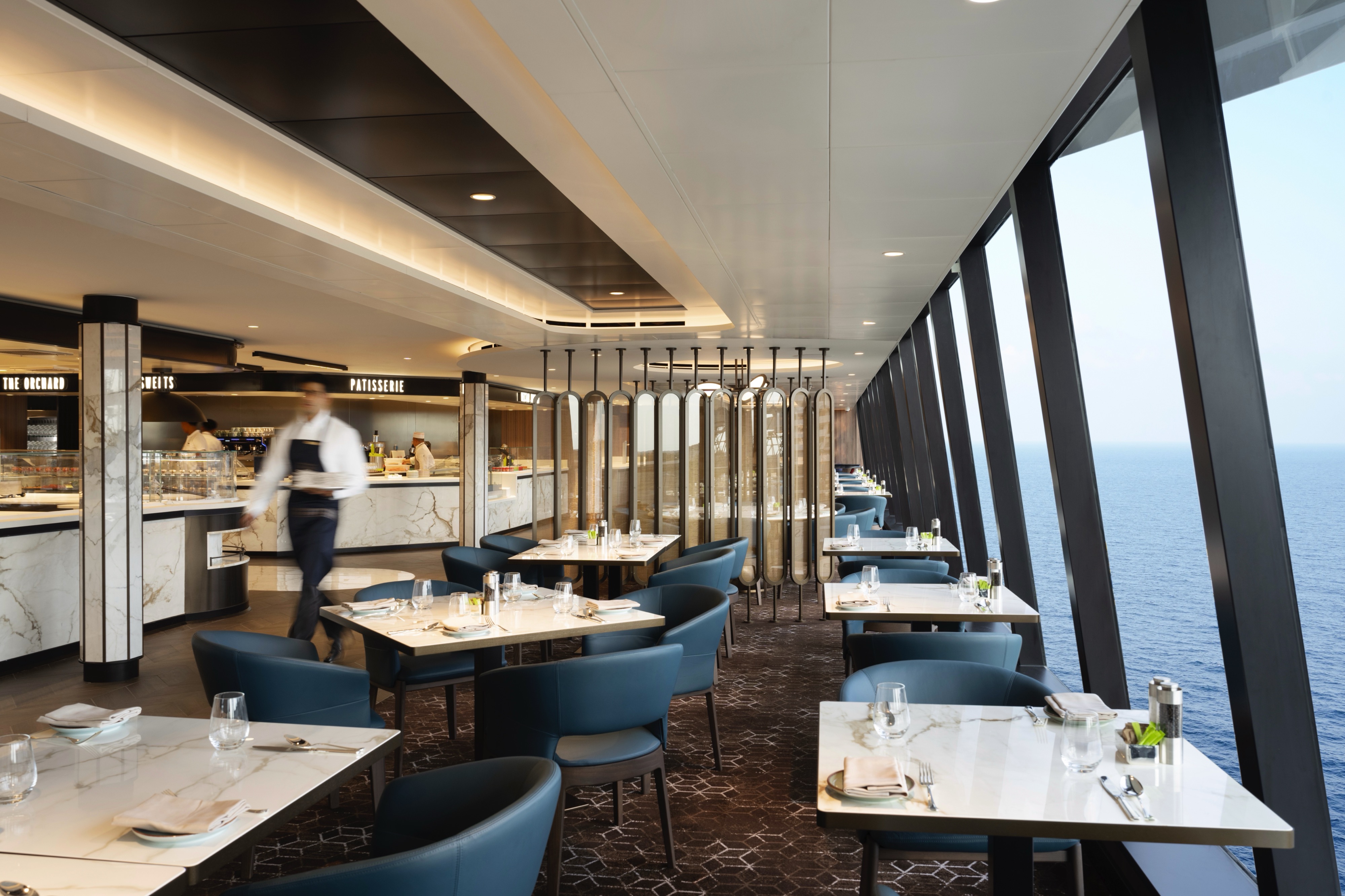
An Emporium is defined as a place offering many different things, a place for merchants to showcase their best produce (coming from the Greek word emporion – ἐμπόριον).
Emporium Marketplace is an effortless all-day dining restaurant, bringing the global culinary talent and produce to the fore to offer diverse cuisines with a focus on quality produce, inspired by local destinations, and allowing guests total flexibility in what they choose to eat, and when.
Bathed in natural bright light, several separate cooking stations evolve throughout the day. White marble and minimalist design take centre stage, allowing the freshest ingredients to make the food the true hero of this elegant relaxed space.
Features include sushi, fresh seafood and a daily rotisserie offering grilled, roasted, and slow-cooked meats. Pasta is cooked to order, and freshly baked pizzas and bread are on offer as are home-made sandwiches. The charcuterie, fromagerie, boulangerie and patisserie stations enhance the experience. Fresh juices, smoothies and acai bowls are provided during breakfast.
A selection of wines, champagne and beverages are available to complement meals throughout the day.
Signature Dishes at Emporium Marketplace
Handmade tortelloni, ricotta cheese, spinach, tomato-sage butter
It’s often the simplest dishes that take great skill – this classic is no exception. Tortelloni are ring-shaped, filled pasta ‘pockets’ that originate in Italy’s Emilia-Romagna region. Made onboard from scratch every day in the authentic Italian way, it’s a process best described as art-meets-science. Carefully sourced flour is used to make dough that has the correct degree of elasticity; this is essential to giving the tortelloni their mouth-watering light and silky texture before being filled with ricotta and spinach, then gently coated in tomato-sage butter.
Plant based chia yoghurt
Our curated chia yoghurt is daily made from homemade cashew milk, creating a fusion of delicious creamy flavours for guests to enjoy each morning.
- Indoor seating: 271
- Outdoor seating: 70
- Open for breakfast, lunch and dinner
- Located on Deck 11
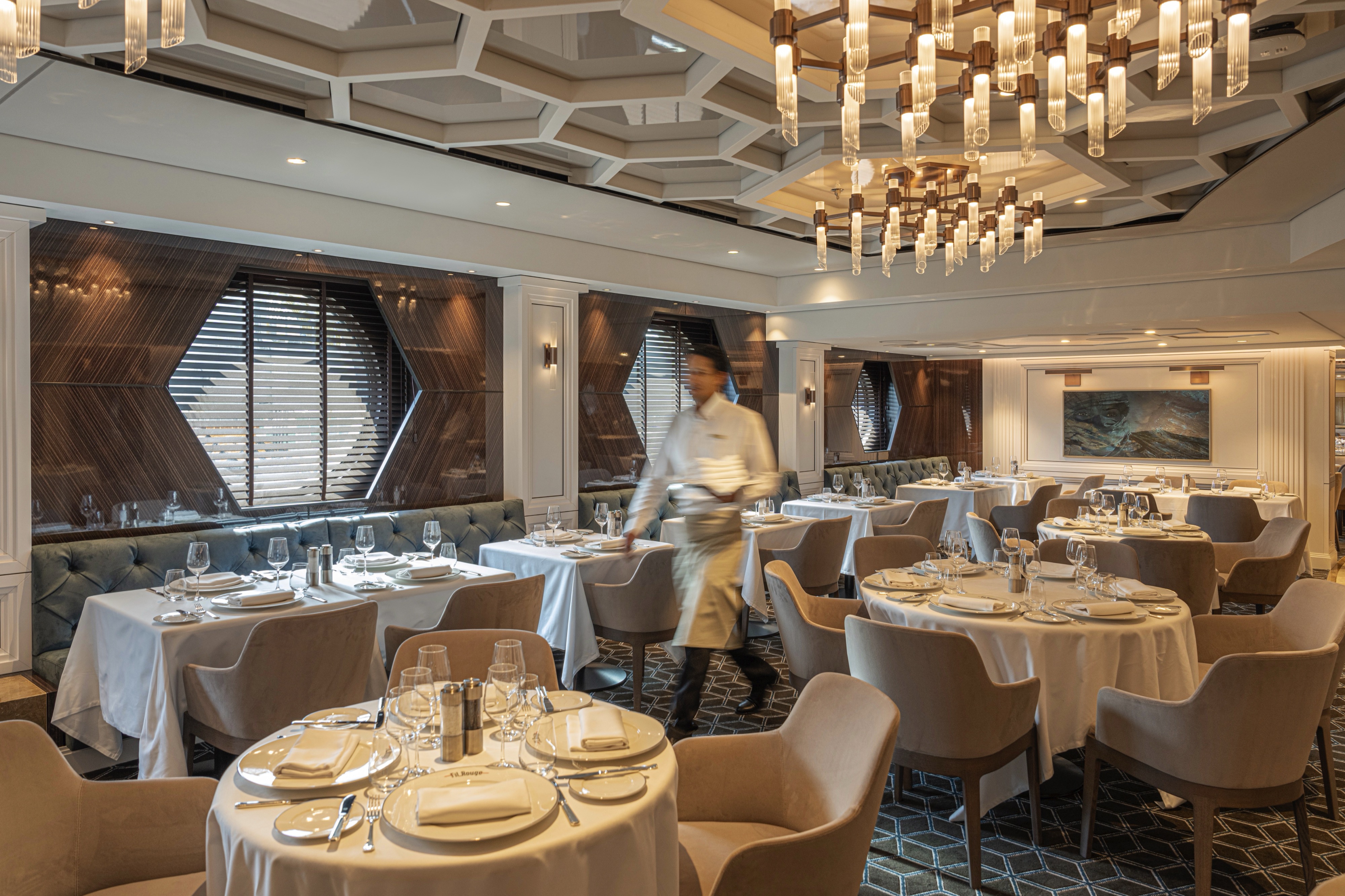
A global tasting tour to French-inspired international cuisine.
A common red thread that unites international flavours with a French influence. Fil Rouge is a sophisticated and intimate restaurant, offering a global tasting tour of French-inspired international cuisine, where guests are encouraged to take their time to appreciate both the cuisine and the intimate ambience.
A universal, timeless dining experience, Fil Rouge is a visual articulation of the fundamentals of elegance. Intricate hexagons representing the simplest expression of perfection contrast with clean white walls adorned with inspiring works of art.
An elegant dessert cart tempts with the freshest creations served tableside, and a superb wine selection showcases the best of both the Old and New World vineyards.
Signature Dish at Fil Rouge
Tuna tataki, crispy tomato-olive tart, vegetables, vanilla white pepper
Sustainably raised and caught in the open Mediterranean Sea close to the Cartagena Bay, the Mediterranean bluefin tuna sourced by our chefs is some of the best grade to be found anywhere in the world for sashimi.
- Indoor seating: 222
- Open for breakfast and dinner
- Located on Deck 4

Private dining and culinary classes.
The Chef’s Kitchen is an immersive experience held in an ocean-front private kitchen setting for 12 guests. Our team of culinary experts guides our guests through a journey of discovering new ingredients, flavours, textures and cultures, regardless of their cooking skills level.
The experience continuously evolves around the regions visited by the ship, and will also extend ashore with visits to local markets and hand-picked producers. The adjacent private dining room is the perfect venue for guests to celebrate their new skills, savour the incredible dishes they created, paired with superb wines from our sommeliers.
- Indoor seating: 12
- An exclusive experience fee applies
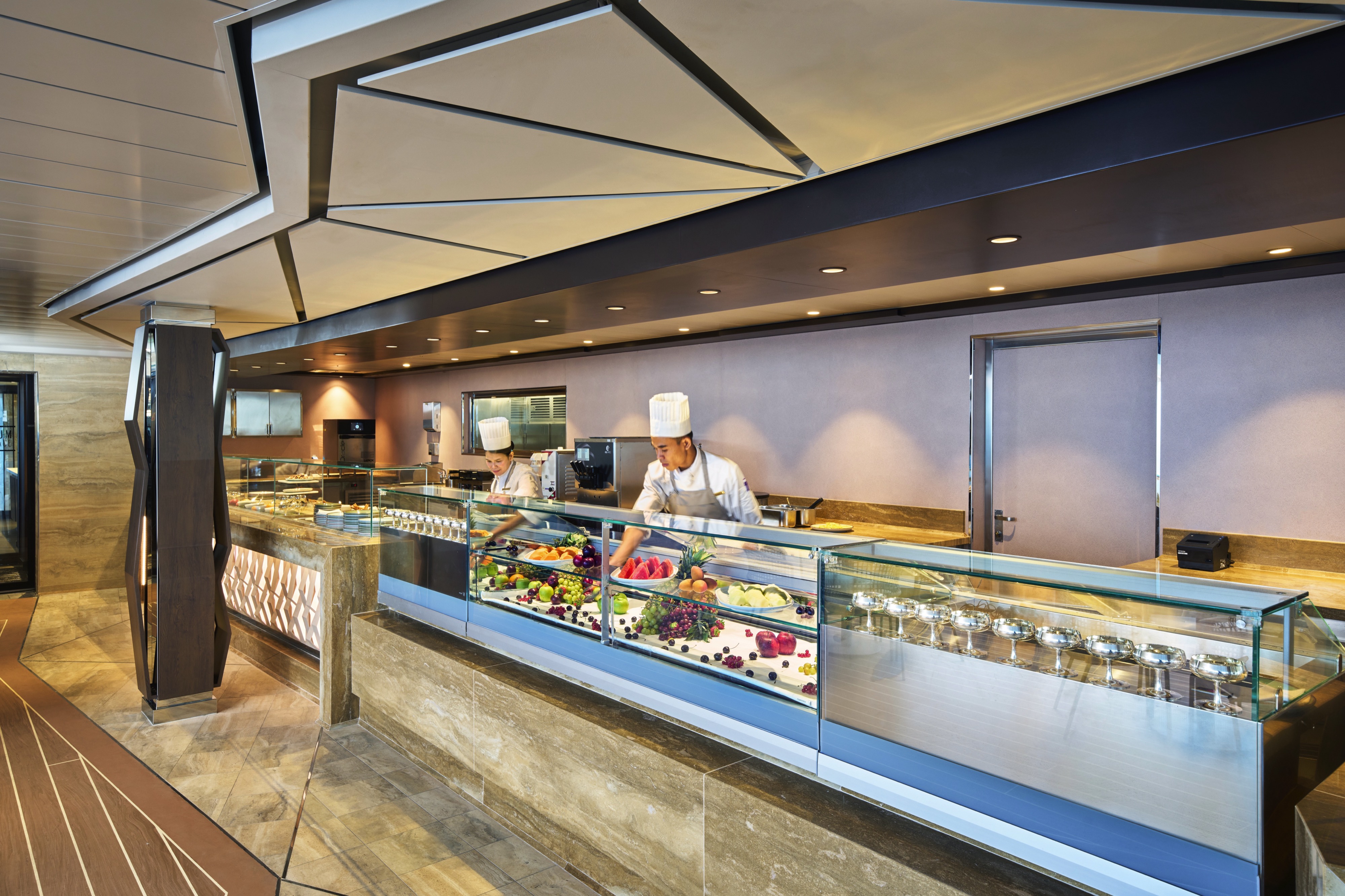
Authentic French and Italian indulgences in a relaxed weather-protected poolside environment.
Set in the relaxed, weather-protected poolside Conservatory, this is the place to treat yourself to authentic French and Italian indulgencies.
- Open during the day
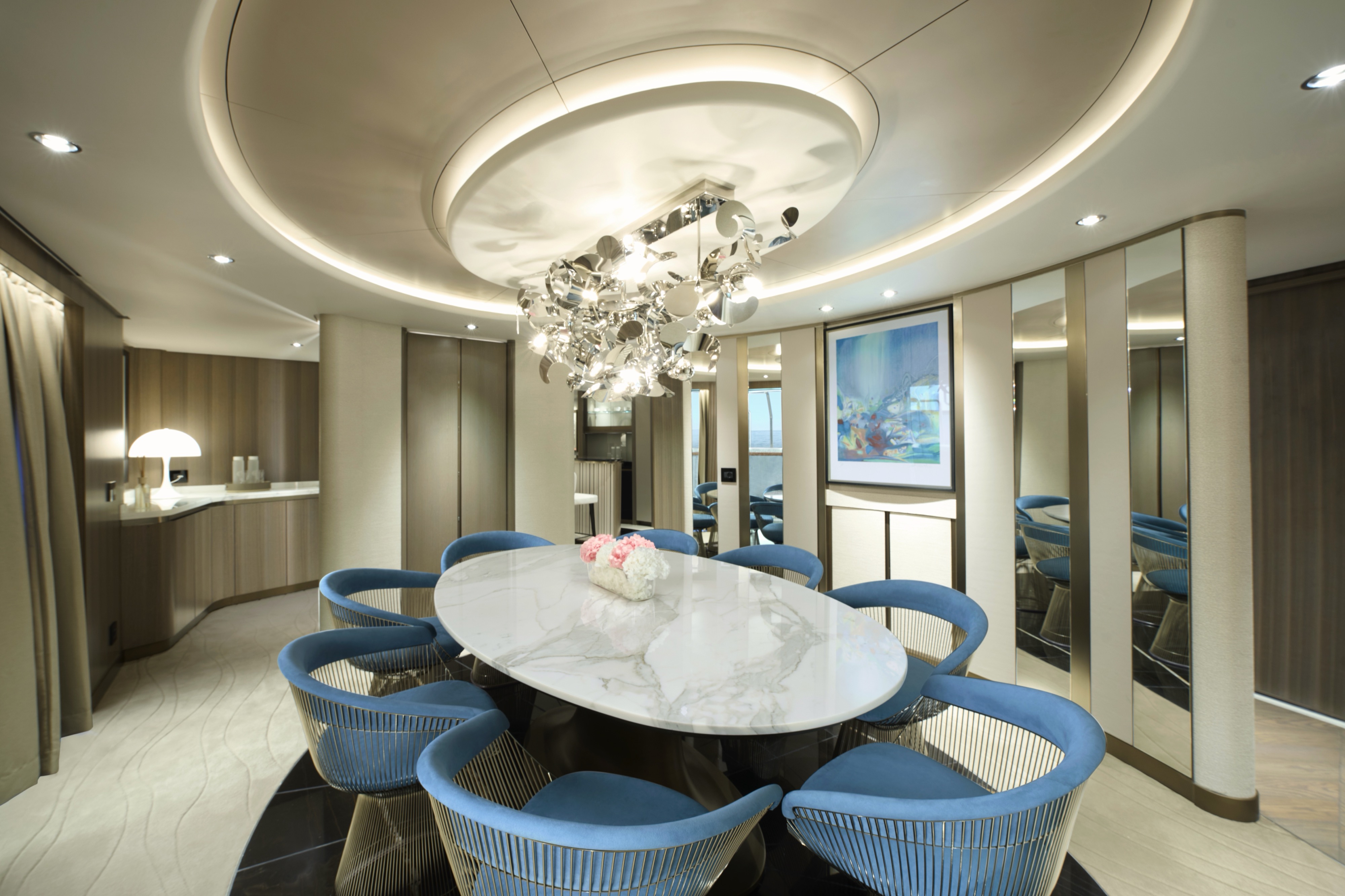
Our guests can enjoy an array of cuisines at any time, day or night, in the comfort of their suite or private terrace. Available 24 hours, the menu offers guests a taste of each of our unique dining destinations.
- Available 24 hours
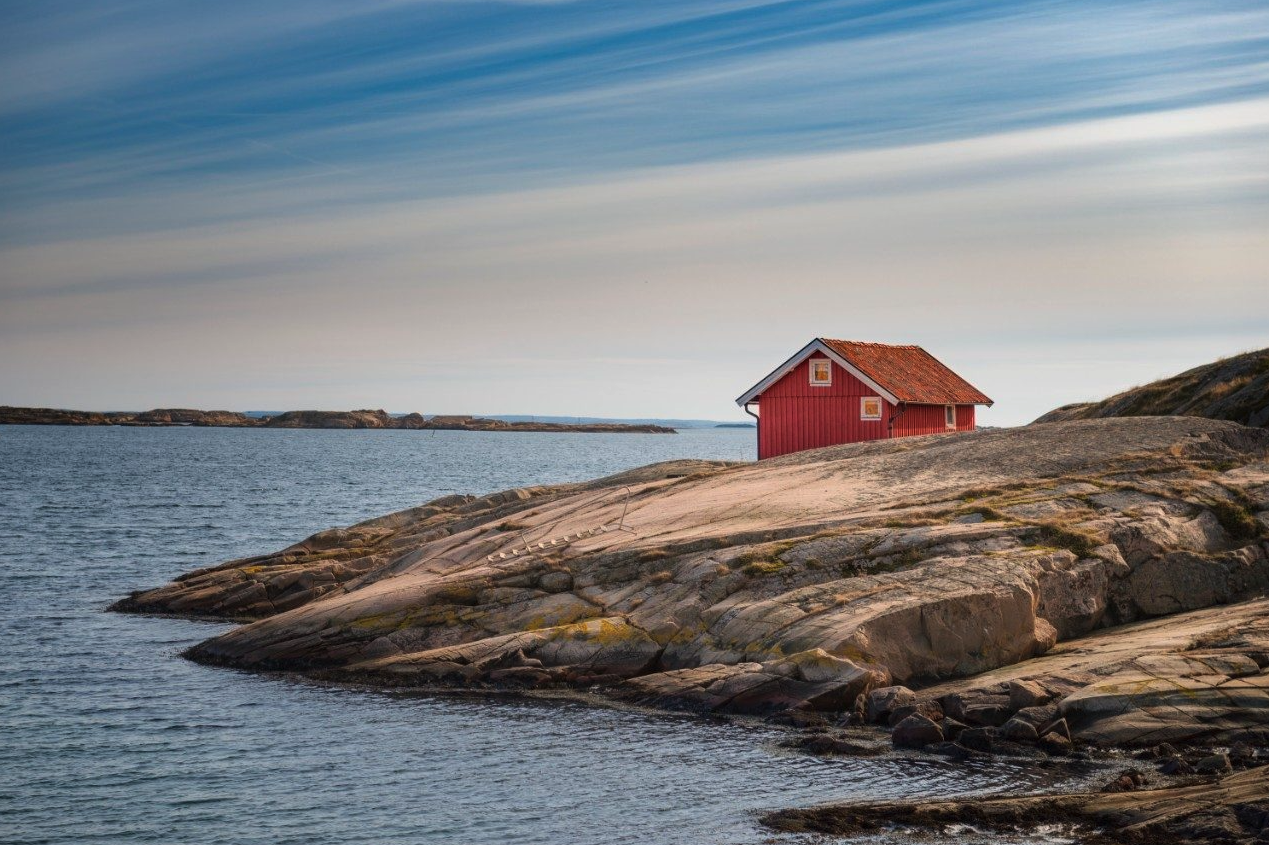
The Enchanting Explorations are the definition of distinction for bespoke groups seeking peerless experiences.
Meticulously designed to usher in next-level exclusivity for small, agile groups seeking peerless experiences, and to witness moments that are off limits to most. You may find yourself in a silent Sistine Chapel after it closes to the public. Perhaps you will sail along the coastline of enchanting Mykonos on a relaxing and captivating catamaran cruise of the south coast, home to some of the island’s best beaches. Or indulge in top-line dinner reservations to a restaurant with a 2-year wait list.

The travel equivalent of haute couture, our Tailored Experiences are tailor-made for those who seek truly customised arrangements that are both personal and without compromise.
We are pleased to curate your requests for singular, customised arrangements that can be as off-the-beaten-path or utterly indulgent as you wish. Whether yours is an intimate group of two or a larger gathering of family and friends, we can help you adapt a featured destination experience or totally tailor an arrangement that delivers exactly where and what you prefer.
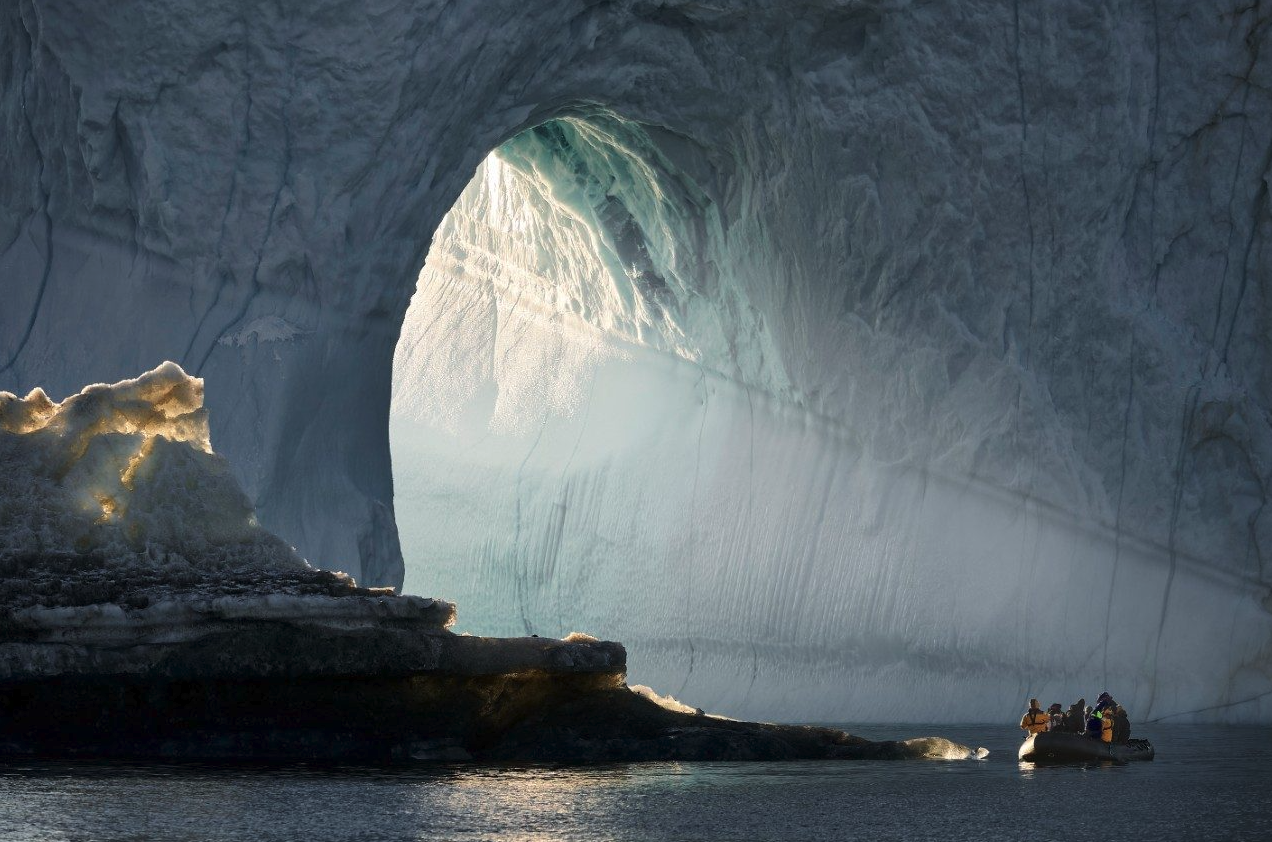
Traversing beyond the bounds of the ocean, we take you deeper into the culture of the countries we visit with immersive all-inclusive excursions.
Designed as three- or more- day overland experiences, our In-Country Immersions are all-inclusive and available to intimately sized groups starting before or after your sailing. All you have to do is let go-and let us immerse you in the extraordinary that lies further afield. Our In-Country Immersions whisk you sunward via private jets or hot-air balloons, nimble ATVs or sure-footed horses to chase nearby marvels, events and wilderness treks both famously celebrated or deeply shrouded in mystery.

Soul-stirring experiences that touch the impossible, from the thrill of supersonic speed to the deepest fathoms of ocean trenches.
Whether you seek the thrill of supersonic speed, the silence of polar mountain peaks, the deepest fathoms of ocean trenches, the sense of awe from meeting world-leading intellects and artisans, these experiences are more than one-off wonderments, they are soul-stirring achievements that will forever influence your perspective of the world and your role within it.
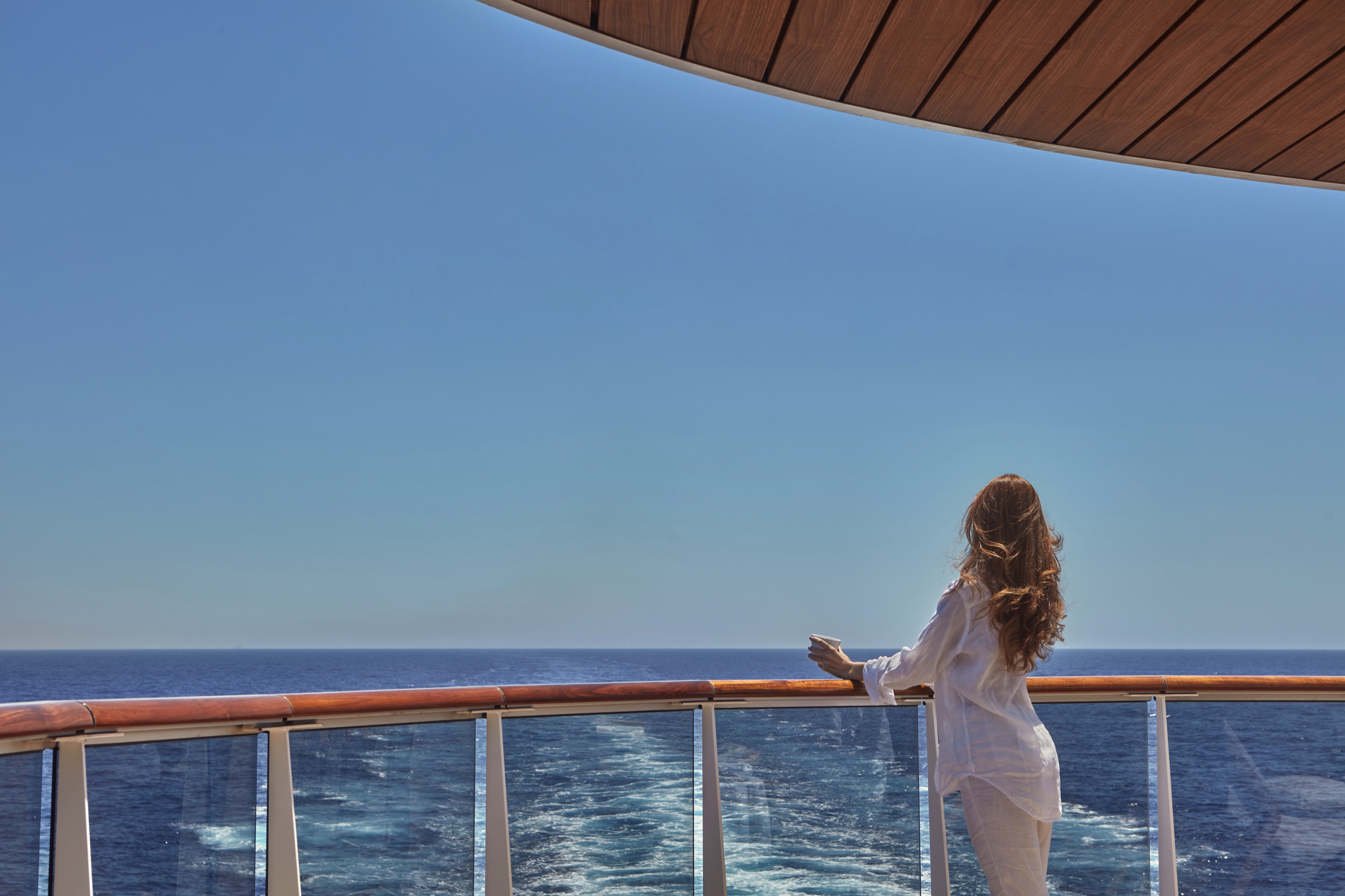
Let our Explora Experience Ambassadors ease you into your travel experience by taking care of essential arrangements before and after your journey.
GUIDING EVERY STEP OF YOUR JOURNEY
Whether on ship or on shore, Explora Journeys guides every step of your journey so you enjoy the same level of personalised service from beginning to end.
SEAMLESS TRANSFERS
Travel with total peace-of-mind, with organised transfers. Float effortlessly through the stresses of travel with airports, hotels, vehicles, and luggage handling all looked after.
LUXURY HOTEL STAYS
Should you wish to explore a destination before or after your journey, our comprehensive hotel programme is the perfect option.

Our Destination Essentials offer must-do experiences in unbridled finesse, hidden wonders and little surprises.
Boutique in nature and bolder in adventure, our Destination Essentials expand must-do experiences with hidden wonders that let you see the world from a debonair perspective. It’s not enough to just go to Cairo’s Great Pyramids or Rio’s Christ the Redeemer; intimately feel the power of their presence, find yourself tingling with goosebumps and experience it in a way that quenches your thirst to do more than anyone else can experience.
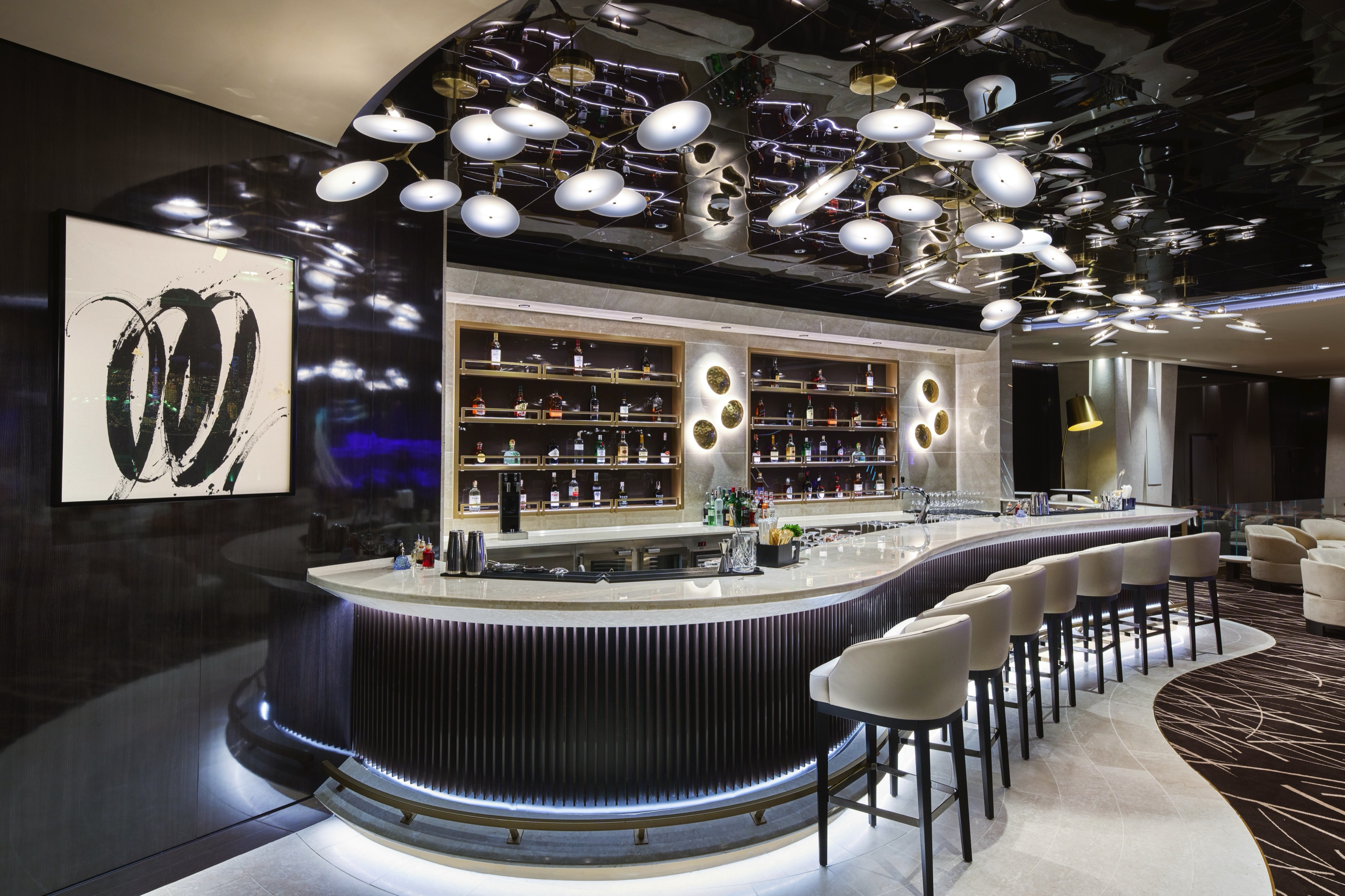
Mixology, enrichment and entertainment continuously evolving throughout the day.
The most spacious onboard lounge features mixology specialists, enrichment activities and cabaret-style entertainment daily. This venue is designed to continuously evolve and transform throughout the day along with the ocean journey.
- Indoor seating: 210
- Located on Deck 4
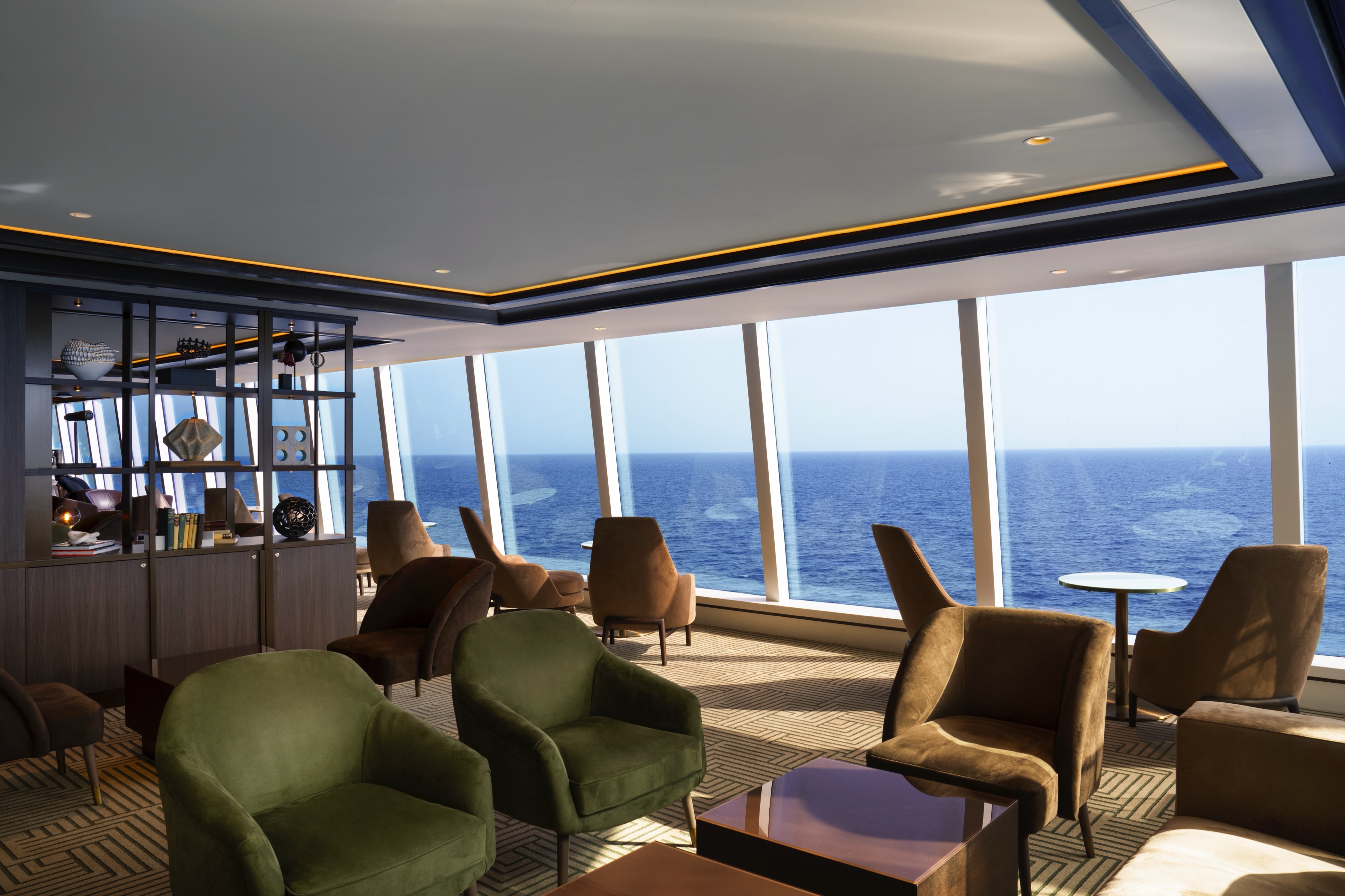
A luminous lounge offering spectacular 270-degree views of the ocean, a spectacular backdrop to informal drinking and dining.
Explora Lounge is a central meeting place bathed in natural bright light, where guests can watch the world sail by as they enjoy light meals, snacks, and traditional afternoon tea. Perfect for a quiet moment to read, work or sip a coffee, or simply admire the beautiful sea-facing views which instantly ease the mind into a calming space.
Cool and soothing background music during the day is transformed into a jazz and piano bar at night. This is the perfect soundtrack to your journey paired with a sunset aperitivo in hand.
Guests can enjoy light meals, snacks, traditional afternoon tea, along with inventive modern cocktails barista-made coffees, loose leaf teas, smoothies, and fresh pressed juices.
- Indoor seating: 149
- Outdoor seating: 38
- Located on Deck 11

An all-day pool and lounge setting for a seaside escape.
An all-day lounge next to the infinity pool, ideal for a seaside escape offering chilled beach club vibes, with low background music by day and acoustic musicians and DJs as the sun sets, continuing throughout the evening.
Outdoor dining is available from nearby Sakura restaurant in bento boxes, conveniently served seated at a table, a lounger or a poolside sunbed.
- Outdoor seating: 122 (Includes sunbeds, lounge chairs and bar seating)
- Located on Deck 5
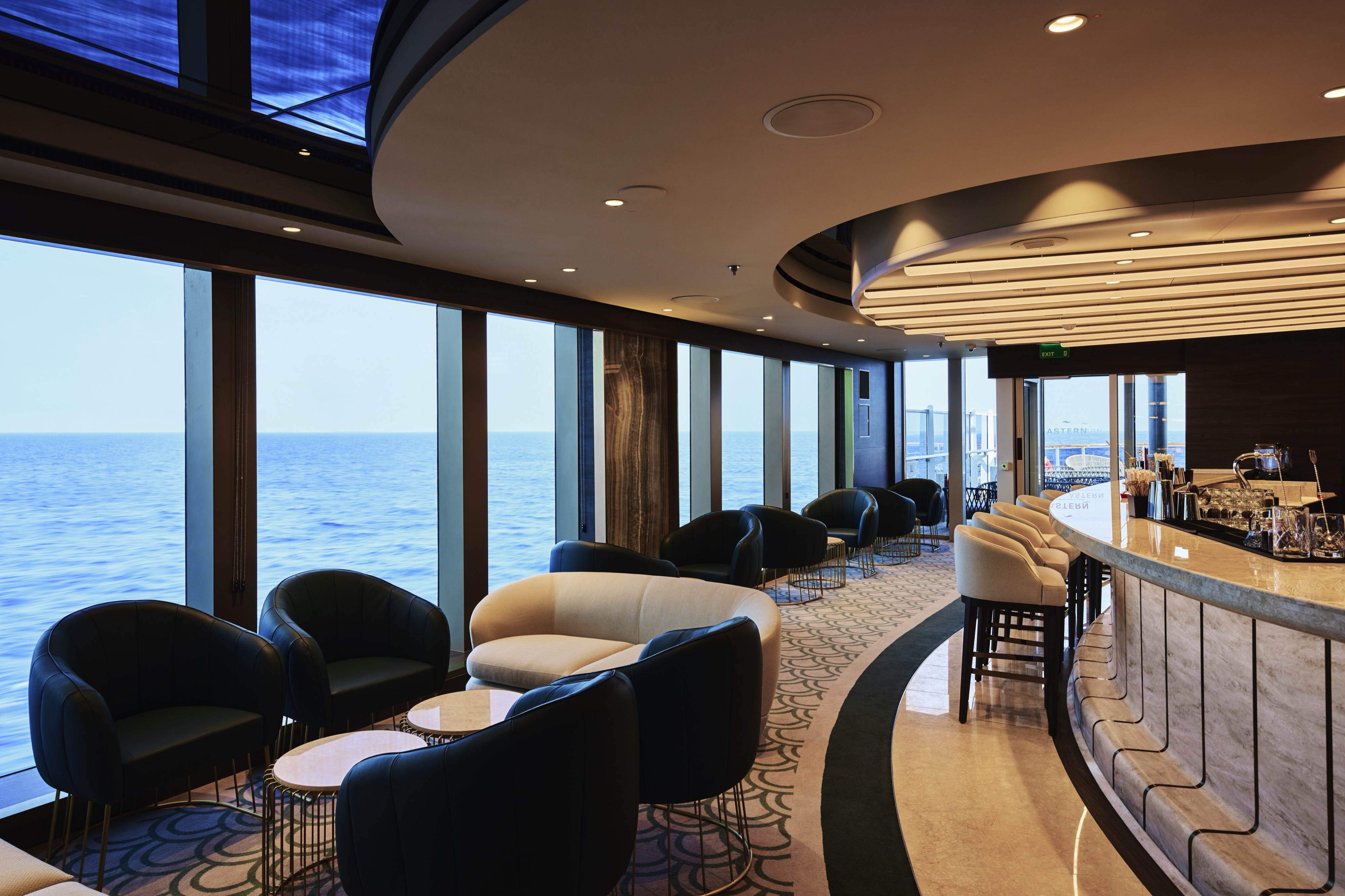
All-day lounge for a seaside escape opening up to the Astern Pool.
Astern Lounge is the social hub of the journey, with a collection of events and rituals suited to every taste.
Effortlessly transitioning throughout the day, Astern Lounge hosts live music, DJ sessions and enrichment insights. Coming to life from sundown, the lounge perfects the aperitivo through a ritual of celebrating the golden hour, complemented by live entertainment.
- Indoor seating: 70
- Located on Deck 5
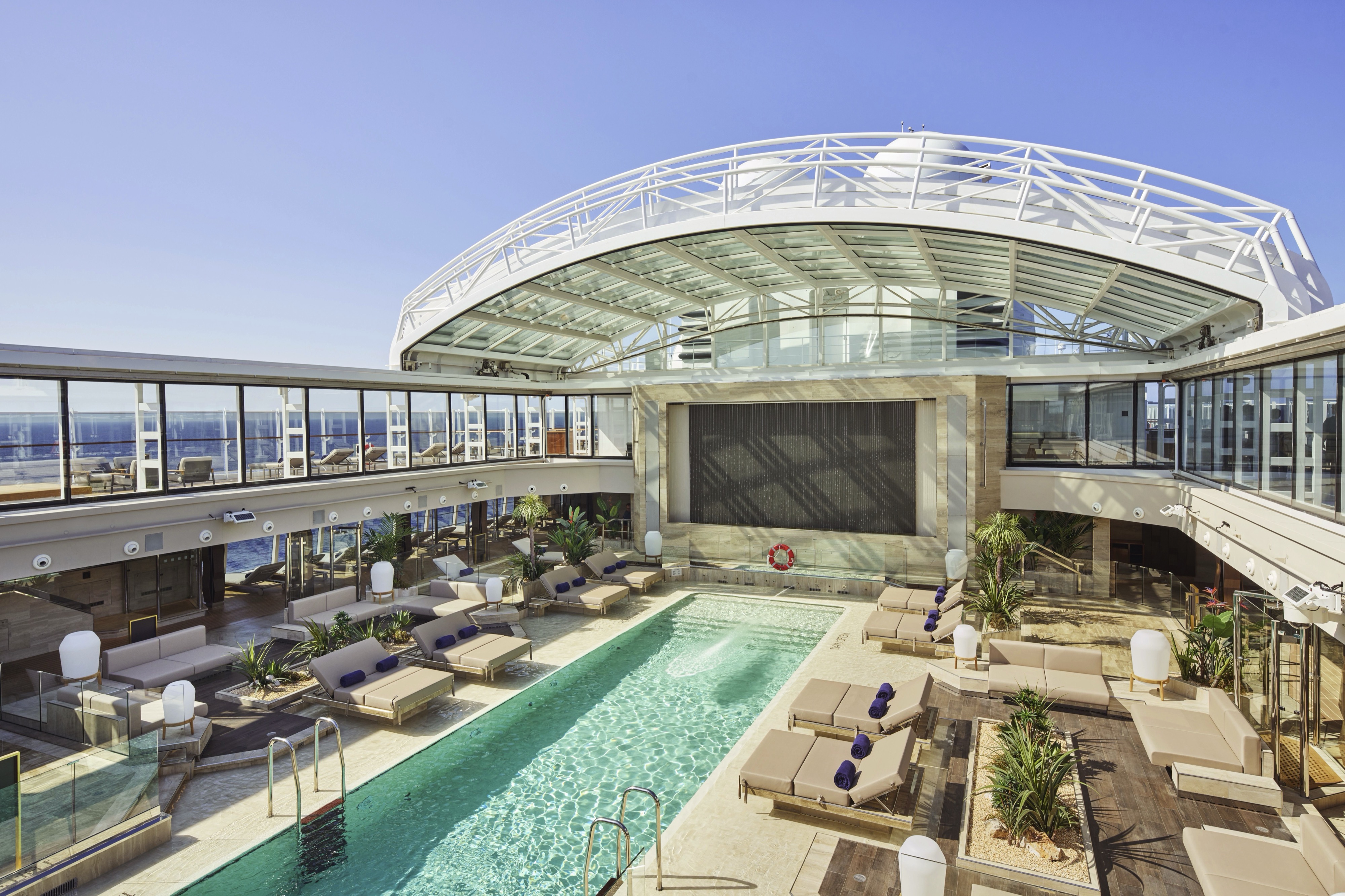
A weather-protected all-day poolside lounge
The Conservatory is a weather-protected poolside lounge by day. By night, it turns into a cinema experience under the stars. A relaxed, calming venue to unwind and enjoy cocktails, with light, lively background music playing throughout the day.
- Indoor seating: 52
- Located on Deck 11
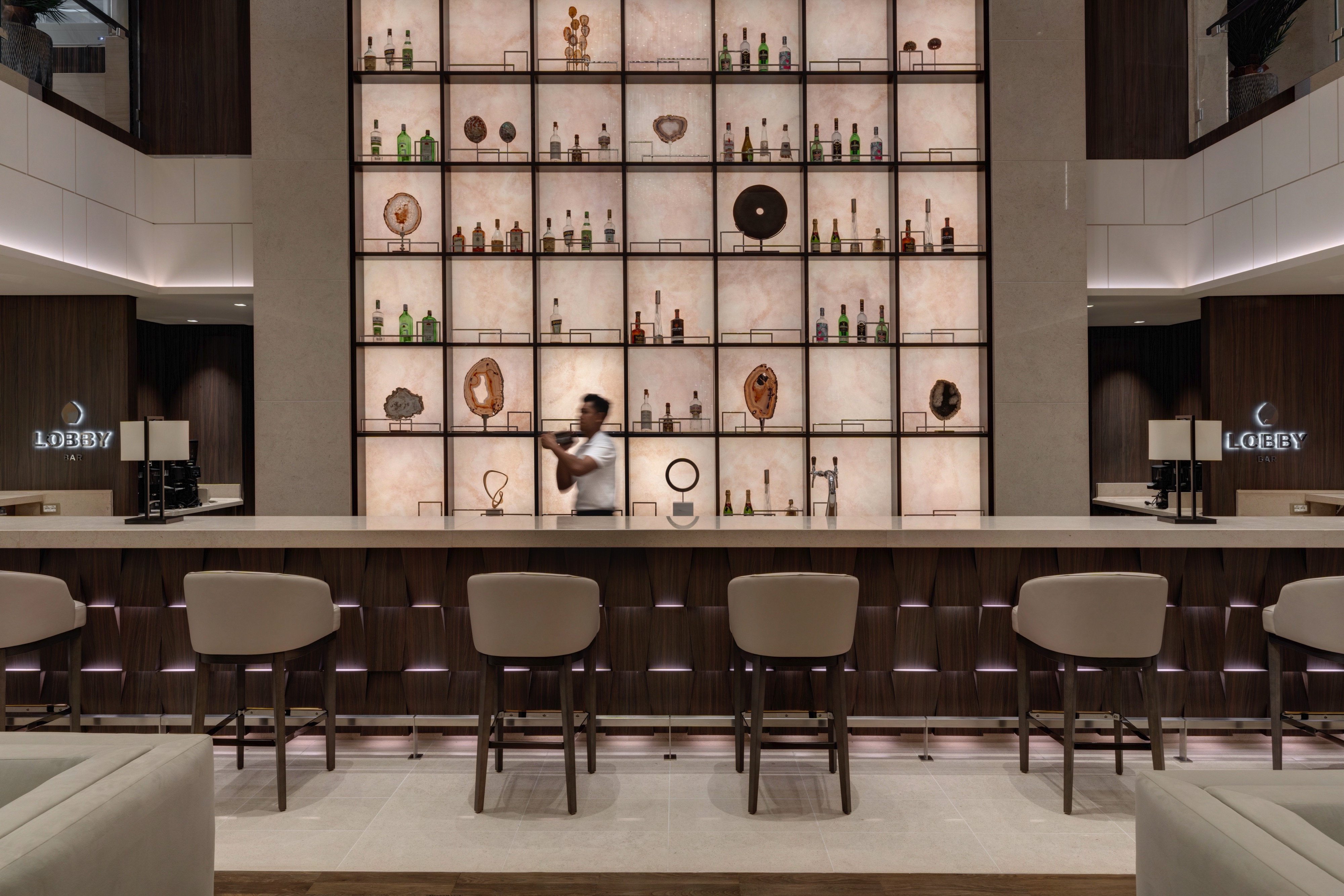
A centrally-located social bar and lounge.
A central gathering social bar and lounge, amongst high-end boutiques, provides the ideal spot to enjoy refreshments throughout the day and night.
- Indoor seating: 40
- Located on Deck 4
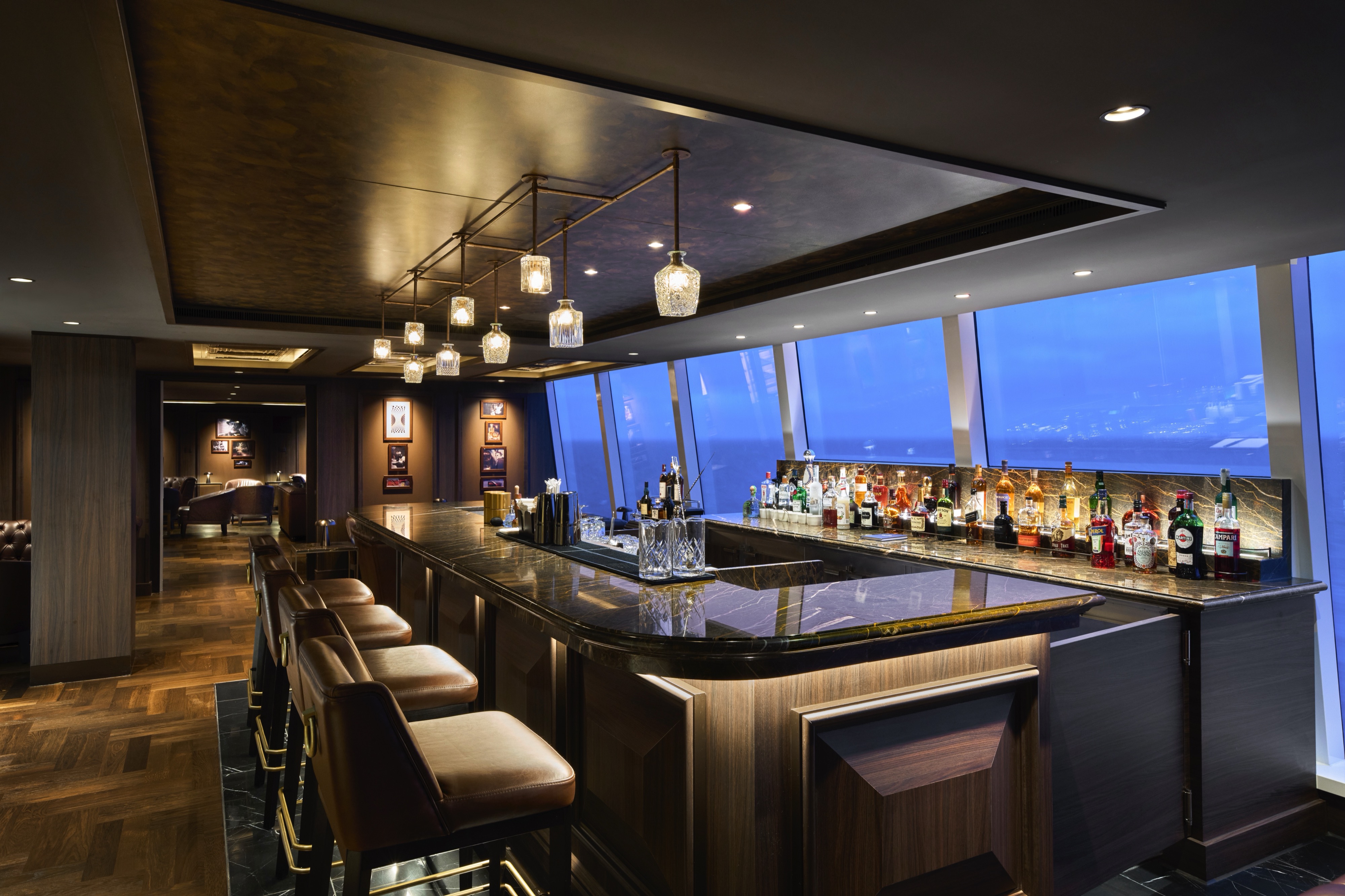
A refined tour of the global whisky regions.
Set within the Explora Lounge, Malt offers a refined tour of the global whisky regions, including some of the rarest whiskies. Complete with a walk-in humidor, cigar expert and a dedicated outdoor cigar-smoking terrace.
A menu with an emphasis on dark brown spirits
Features an outdoor smoking area for guests to enjoy their hand-rolled cigars*, selected with the guidance of our cigar expert
Signature whiskey-based cocktails curated exclusively for Explora Journeys
Low jazz background music
- Indoor seating: 20
- Located on Deck 11
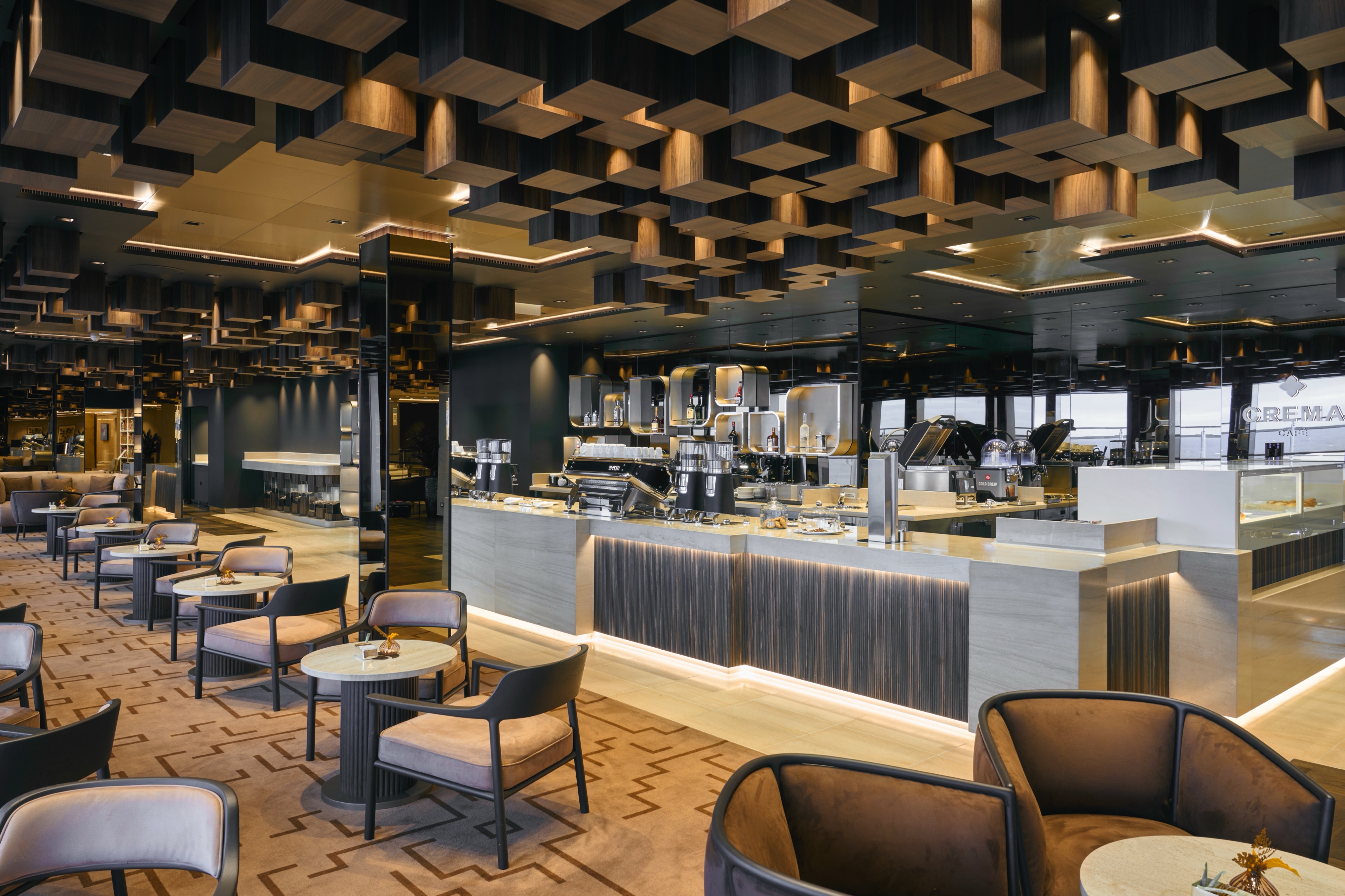
Bustling European all-day café culture brought to the oceans of the world.
A thick luxurious layer of crema nods to the freshness of an espresso and aptly lends authenticity and sophistication to a café at the centre of life on board.
Inspired by modern European café culture, Crema Café has unpretentiously stylish interiors with comfortable lounge seating, featuring sophisticated reading material and art set against uninterrupted views of the sea. A place designed to meet, discuss, unwind, taste and indulge, where like-minded guests gather to mingle and converse.
Coffee is chosen by selected connoisseurs who have travelled the world exploring fair-trade coffee origin, character, and strength. Discover the refined methods of brewing coffee from skilled baristas, taste high-quality loose-leaf teas with an on-hand tea expert, or enjoy refreshing cold-pressed juices. A jewellery-shop-like display showcases pastries, cakes, desserts and dry sweets including madeleine, cannelés, biscotti, navette sandwiches as well as gelato flavours that evolve throughout the day.
- Indoor seating: 62
- Outdoor seating: 16
- Located on Deck 5
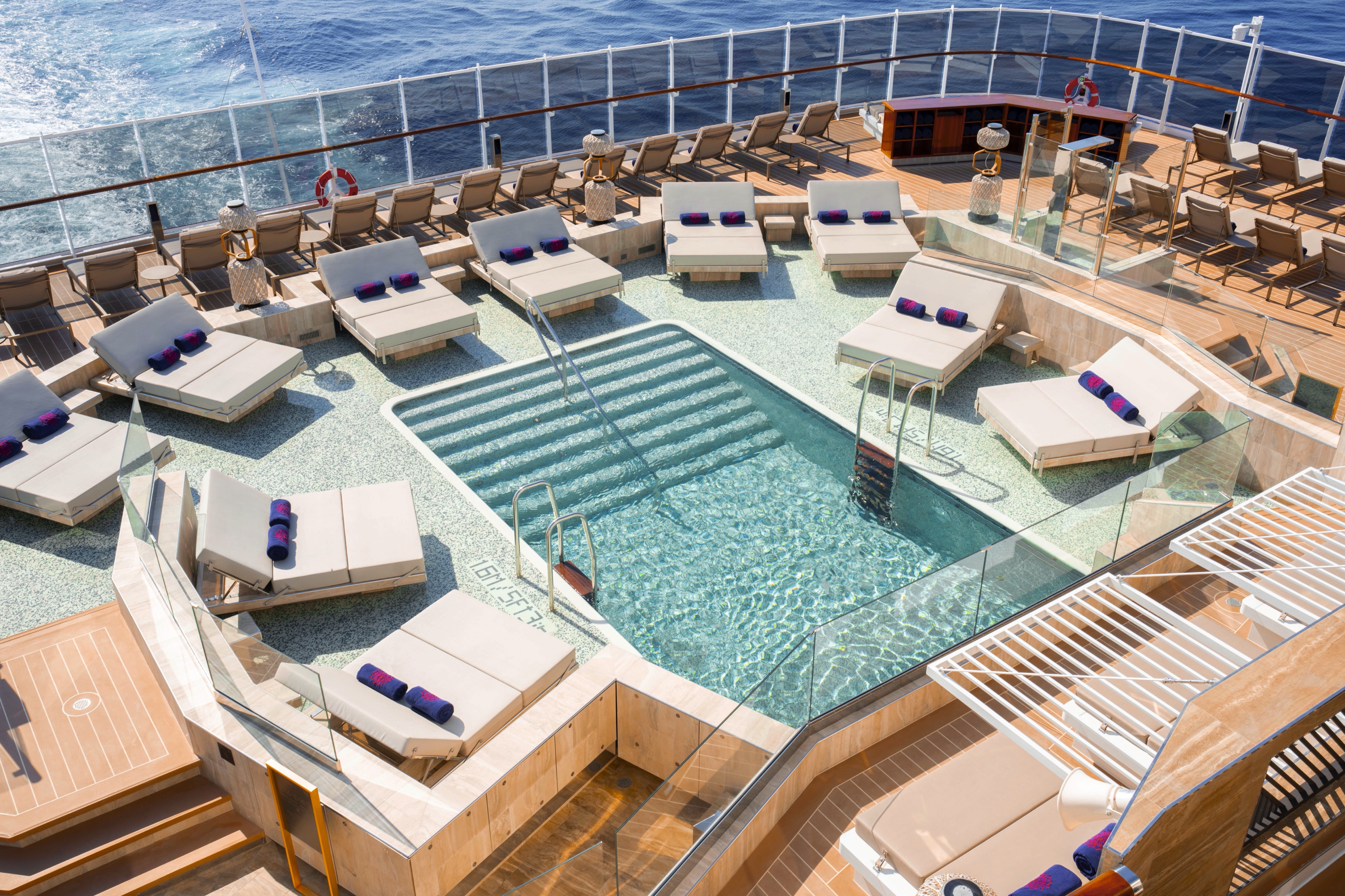
An intimate pool with a chilled vibe throughout the day.
Here, guests can enjoy the sun, sea and serenity along with sunny, sparkling and colourful drinks.
- Outdoor seating: 138 (Includes sunbeds, lounge chairs and bar seating)
- Located on Deck 10
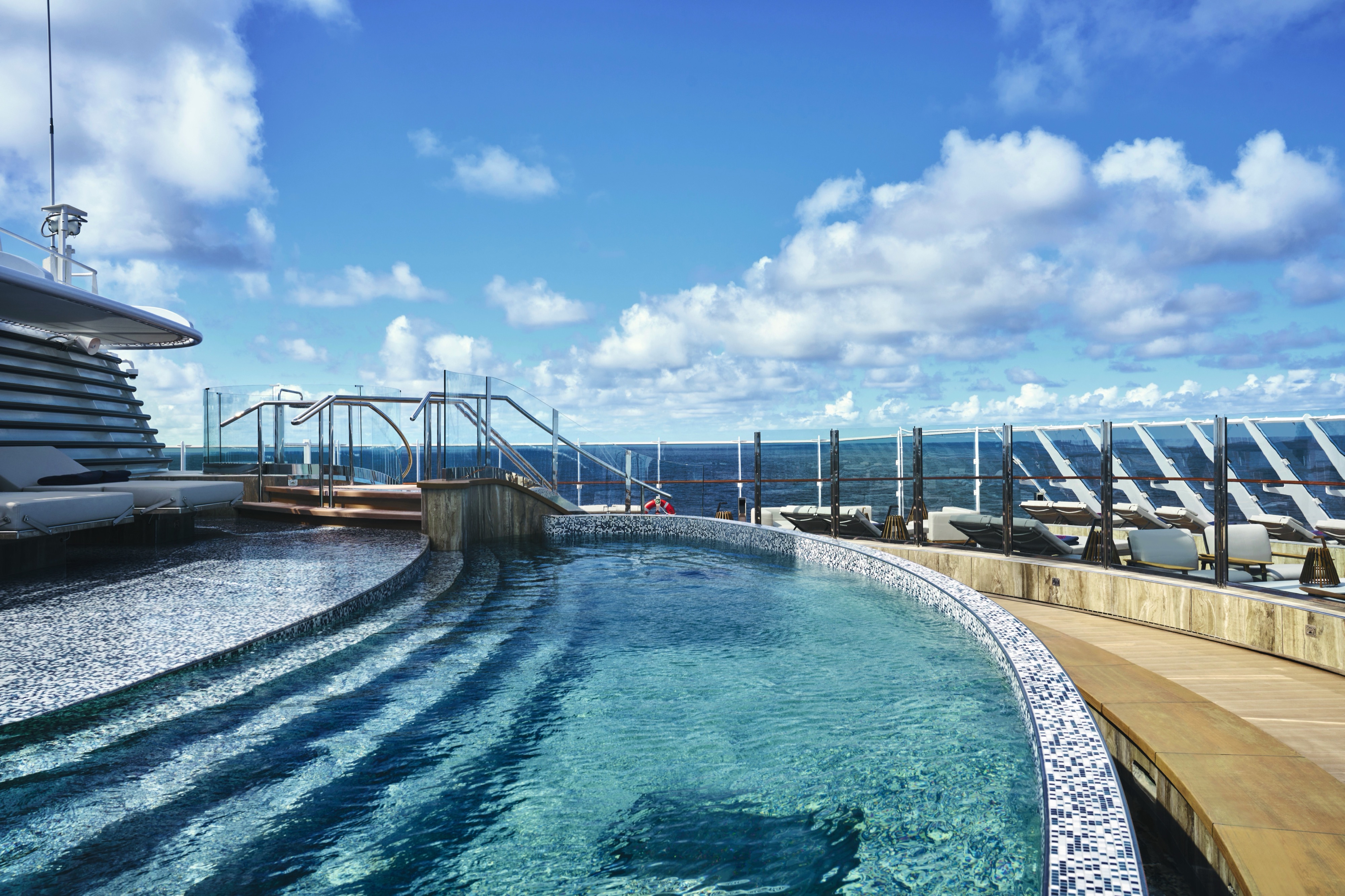
A panoramic adults-only pool and lounge experience.
Inspired by the Ancient Greek god of the sun, and also literally meaning “sun” in Greek, this adults-only area is indeed the sunniest venue onboard, panoramically facing forward on deck 12. Enjoy lying by the pool or lounging throughout the day as you watch the ship sail through the sea.
- Outdoor seating: 100 (Includes sunbeds, lounge chairs and bar seating)
- Located on Deck 12
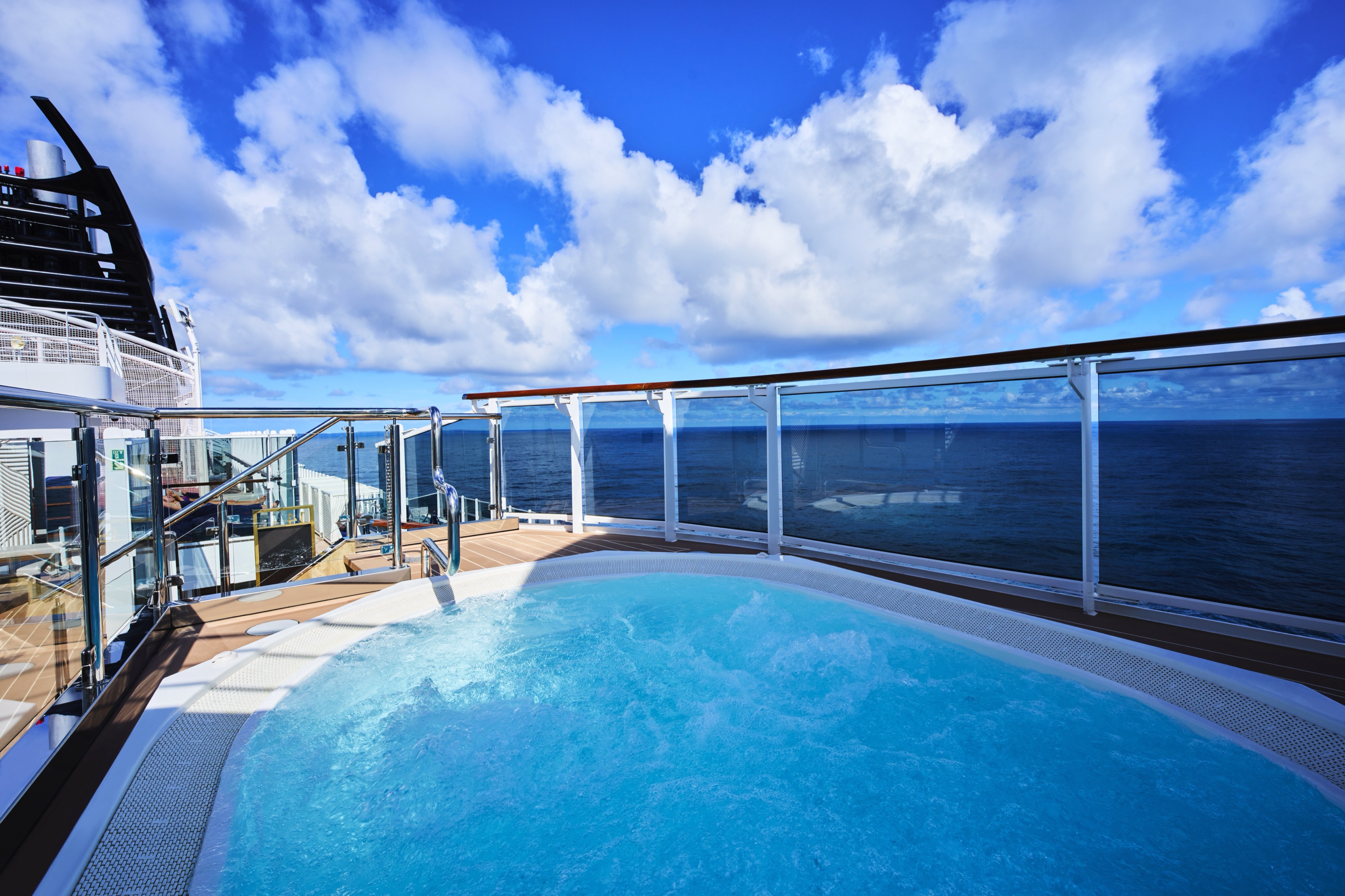
A panoramic outdoor lounge setting, ideal for soothing cocktails and infinite views.
Set on the ship’s highest point, on deck 14, this panoramic outdoor lounge setting is ideal for soothing cocktails and infinite views.
- Located on Deck 14
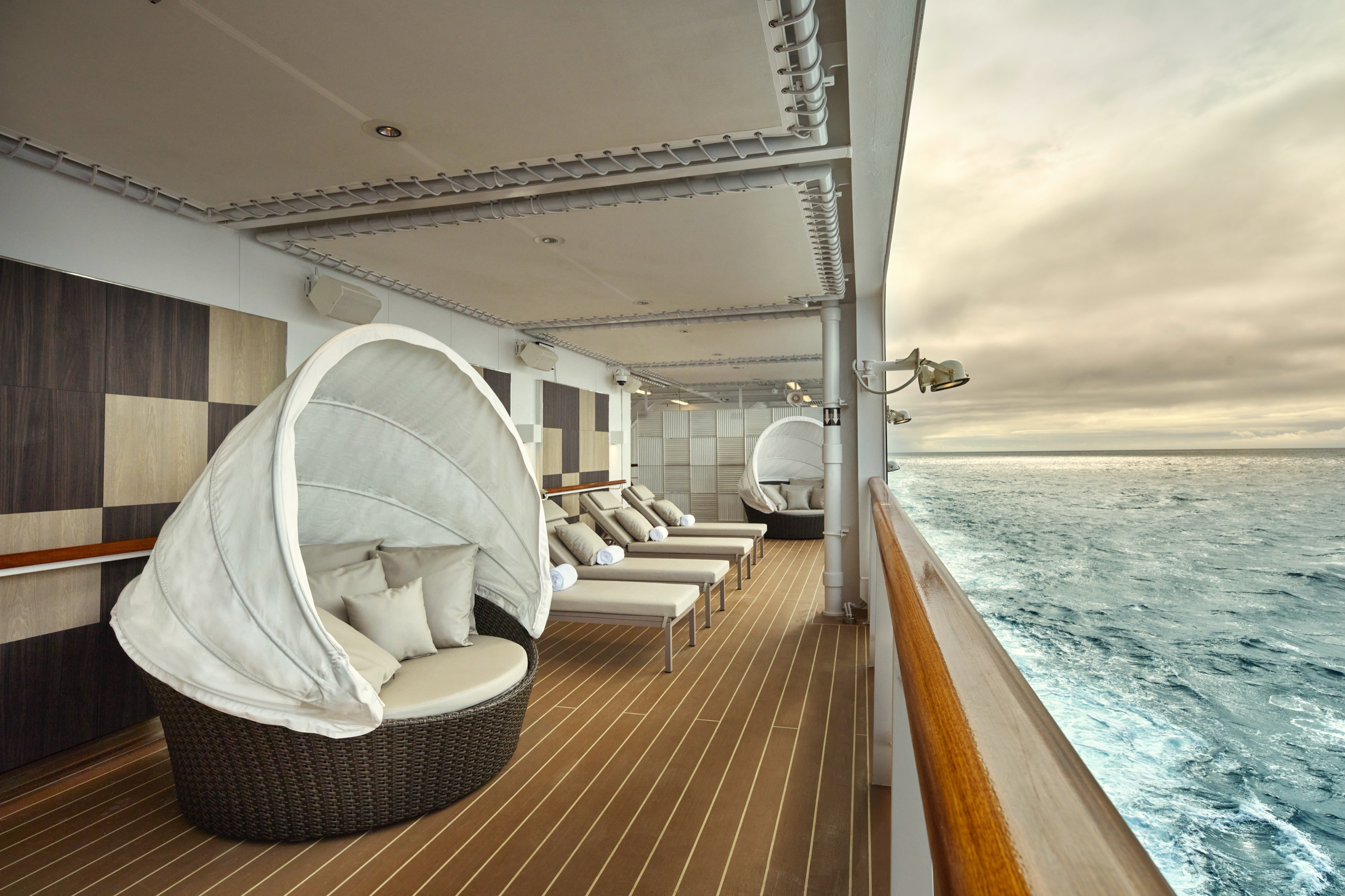
A calming space designed to reconnect guests to themselves – influenced at every level by the calming presence of the ocean.
The spa is where the pressures of daily life dissipate to insignificance amidst a sensory journey to the Ocean State of Mind.
Facilities
- Steam Room
- Steam shower (in private spa suites)
- Hydrotherapy pool
- Finnish sauna
- Salt cave
- Experience shower
- Ice fall
- Heated marble loungers
- Relaxation room
* Spa treatments, including massages and facials, require a minimum age of 12 years old, with parental supervision. Access to our Wellness Area and thermal facilities is reserved for our guests aged 16 years old and above.
11 Treatment Rooms in total of which
- 2 Private Spa Suites with a dedicated outdoor relaxation area
- 1 Double treatment room
- 7 single treatment rooms
- 1 single treatment room for specialised skin treatments – the Medi Luxe Treatments by Dr Levy Switzerland
- Outdoor relaxation area
* Spa treatments cannot be booked until 60 days prior to the journey.
The Spa Facilities:
- Steam Room – A regenerating oasis of psycho-physical wellbeing. Air, steam, and scented fragrances combine and gently rest on the skin, making natural exfoliation easier and increasing perspiration.
- Experience Shower – A multi-sensory journey, the warm shower is complete with fragrances and soft colour lights, offering moments of utmost pleasure – either at the beginning or at the end of the day.
- Hydrotherapy Pool – Designed to create moments of authentic psycho-physical regeneration.
- Finnish Sauna – The ideal space to unwind, reduce stress, strengthen airways, relax your muscles, and oxygenate your tissues.
- Salt Cave – Walls are covered in Himalayan salt bricks, allowing guests to inhale Himalayan salt-infused air, which releases negative ions into the air.
- Steam Shower – A shower that combines the relaxing heat of the steam and the regenerating freshness of water. (* Available within private Spa suites)
- Ice Fall – The Ice Fall regenerates the body after intense heat exposure in the Finnish Sauna or Steam Room.
- Heated Marble Loungers – Equipped with an infrared system that radiates the heat on the whole stone surface.
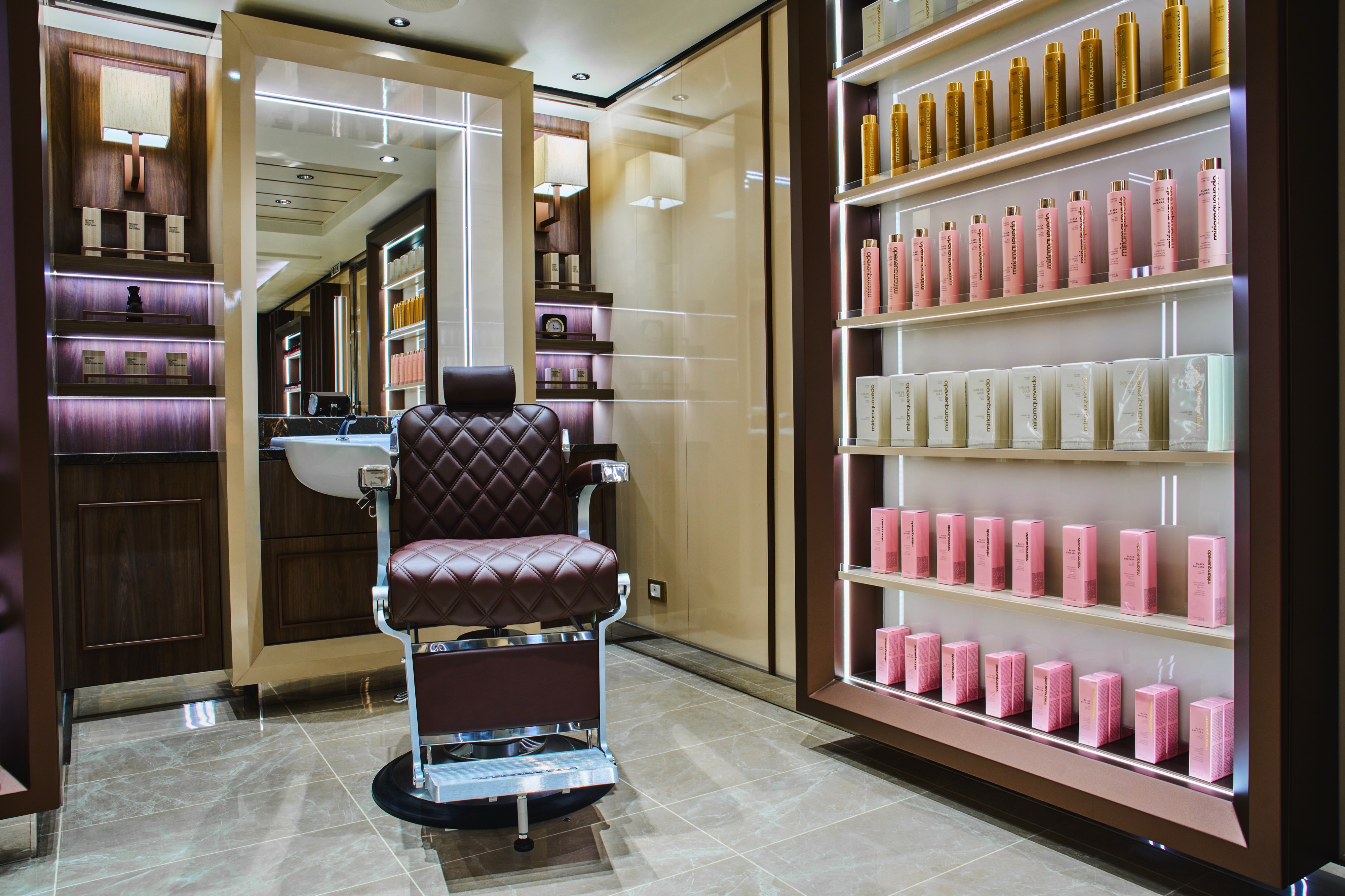
We believe inner wellness should radiate in outer beauty and confidence. Our beauty spaces are dedicated to this philosophy, allowing you to feel at one with the natural beauty of your surroundings.
The Beauty Studio is a flowing space, to ensure all your beauty needs are catered for in one space, ranging from hair rituals, barber treatments to rejuvenating hand and foot treatments.

Seize the benefits of sleep, accompanied by the soothing soundtrack of the ocean.
The Fitness Centre features different areas for cardio, strength, and functional training. Guests can train with high-end cardio equipment from the Technogym Artis Line, a unique collection designed to the highest standards to maximise the efficiency of a workout and optimise results. Among the many options, guests can elevate their indoor running experience and enjoy engaging content and workouts with Run Artis, or train in a fun and effective way on the elliptical Artis Synchro.
In the strength training area guests can work on their lower body with high-quality solutions such as the Artis Leg Press and Artis Leg Curl, or train their upper body with innovative products such as the Artis Chest Press and the Artis Shoulder Press.
For strength workout sessions, Explora Journeys also offers guests the Technogym Bench, the innovative, functional and strength training station with sleek design and enclosed tools that enables guests to perform over 200 exercise options, and fitness tools such as Urethane Dumbbells, which allow guests to be precise in their workouts and recruit more muscles more efficiently.
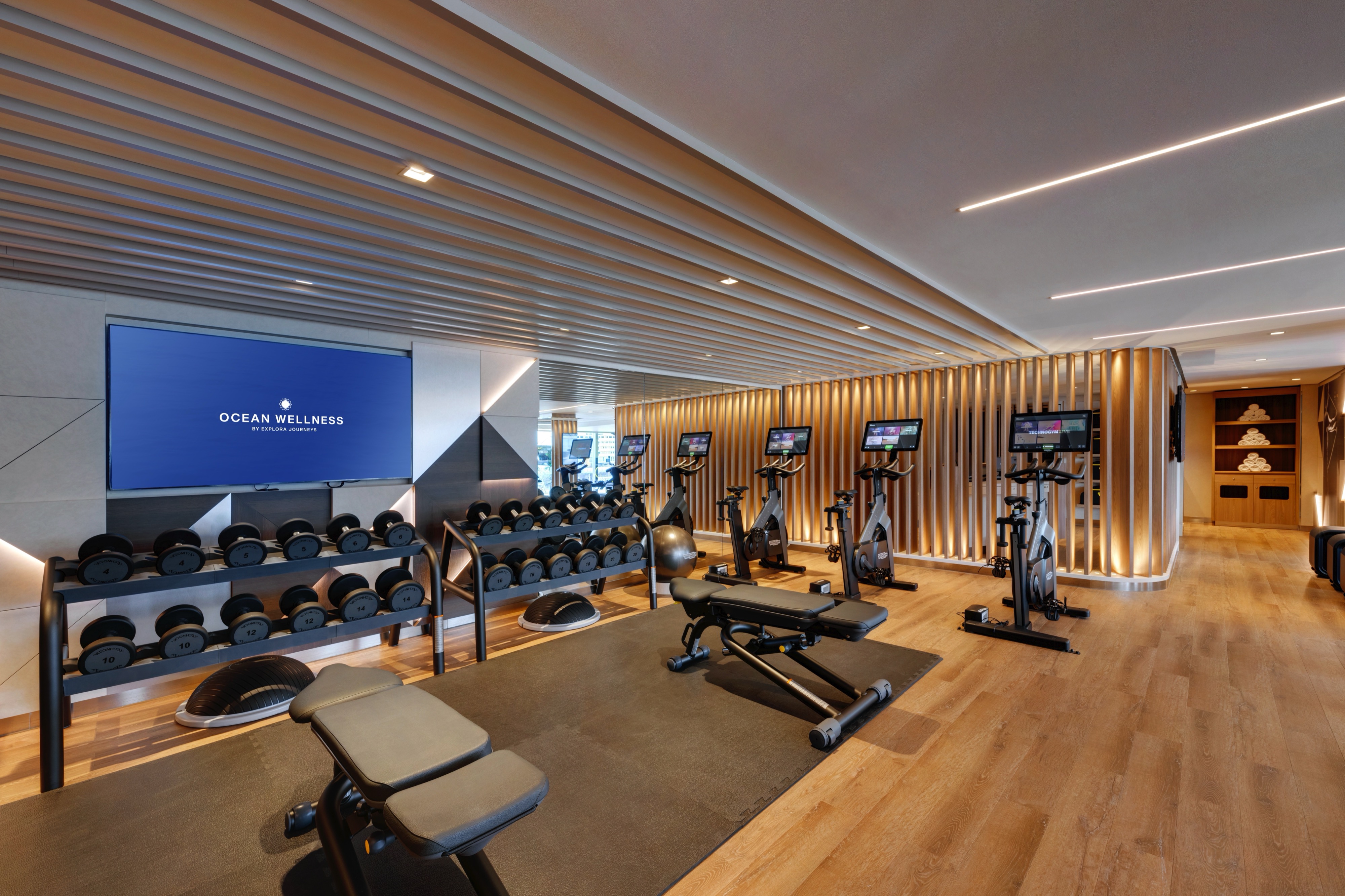
Located within the Fitness Centre, the Fitness Studio allows guests to take part in yoga classes with the Technogym training mats, which offer extra-large size and maximum comfort, or enjoy functional workouts with the Technogym Bench, Technogym Skill tools and the Technogym Case Kit, a practical and spacious bag with a QR code on the hangtag, that allows for direct access to a digital library of video exercises and guided routines focused on their needs.
Additionally, our Fitness Studio offers Pilates Reformers classes for improved balance through the strengthening of the core muscles.
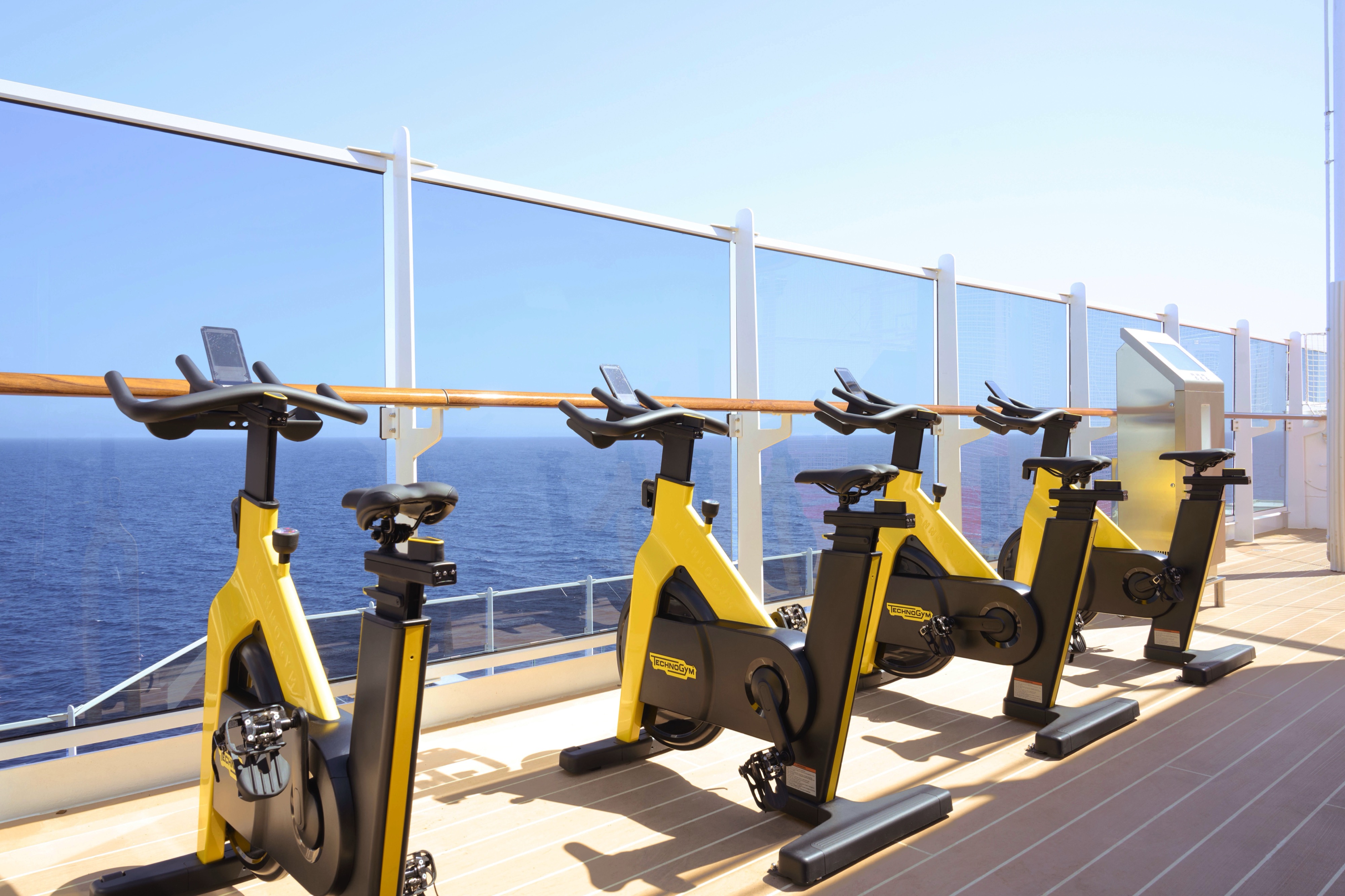
On the outdoor deck, guests can train in the open air, with direct ocean views. The Open Air Fitness area provides guests with the latest fitness equipment such as:
- SKILLROW, the first outdoor rowing equipment designed to improve anaerobic power, aerobic capacity and neuromuscular abilities in one solution
- GROUP CYCLE BIKES, perfect to create an engaging cycling experience.
- TECHNOGYM CASE KIT
Guests can use Skillrow, Group Cycle bikes and also Technogym Case in the way they most prefer: they can choose to train individually, receive support from a qualified personal trainer, or participate in exciting and engaging fitness classes.
More exercise options in the open air include:
- RUNNING TRACK: Encircling the ship is a 360º track where runners can enjoy commanding ocean views while they do laps.
- SPORTS COURT: The ideal space for touch tennis, half basketball, or yoga ritual experiences.
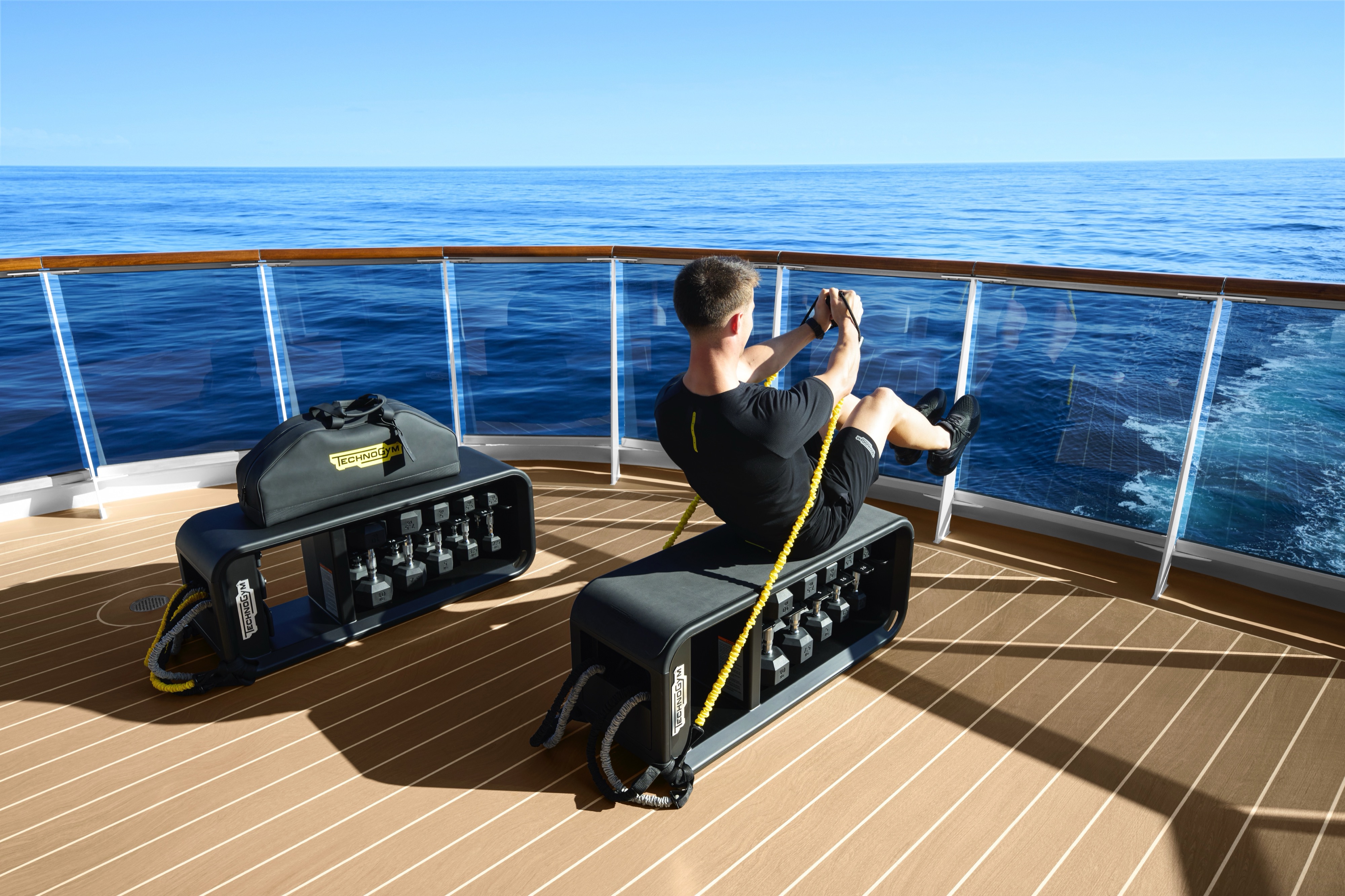
Enjoy the all-inclusive functional training kit that empowers you to perform myriads of total body workouts, with the guidance of the Technogym virtual coach.

A dedicated space for various activities, such as touch tennis, half basketball and yoga ritual experiences.
The use of the space is complimentary for all guests and the equipment such as balls, rackets and other will be provided on board free of charge.
We don’t have a dress code onboard but we suggest an elegant resort casual style.
Please consider the following in our restaurants, and indoor bars and lounges:
- Swim wear and bathrobes are not allowed throughout the day in any of the restaurants and indoor bars and lounges.
- Shorts and sleeveless t-shirts are not allowed during dinner time (18:00 – late) in Anthology, Fil Rouge
- Baseball caps and sportswear are not allowed during dinner time (18:00 – late) in Anthology, Fil Rouge, Sakura, Marble & Co. Grill, Med Yacht Club.
Explora Journeys respects the needs and desires of all guests and we have considered carefully the subject of those who smoke and those who do not. In compliance with global standards, smoking is freely permitted in dedicated areas throughout the ship and those areas are equipped with a special air extraction system. Smoking is strictly prohibited in the suites and the suite terraces.
Smoking will only be allowed on the outside area of the cigar lounge as well as in the following areas:
- Deck 5: Starboard Side on the outdoor Crema Café Promenade
- Deck 11: Forward, Port Side, outdoor area of Explora Lounge
- Deck 12: Forward, Port Side, Cigar section of Helios Bar
- Deck 14: Aft, Starboard Side, section of Sky Bar on 14
If you have a service animal to assist you, please let us know when placing your booking.
We offer a self-service guest laundry as well as a laundry service (charges apply).
There is a medical centre onboard equipped for first aid and minor conditions only. The medical centre is not equipped as a land-based hospital and the doctor is not a specialist.
Medical consultations onboard are fee-based therefore we strongly recommend that you have comprehensive travel health insurance covering medical treatment, repatriation costs and expenses.
There are accessible suites onboard Explora Journeys.
Any guests in need of special services during their journey, or needing to travel with medical apparatus, including wheelchairs, motorised scooters or oxygen therapy are asked to please notify us in writing prior to final payment becoming due.
Certain Destination Experiences are wheelchair-accessible and there will be an icon to highlight these experiences. Depending on what the guest’s requirements are, experiences may be subject to availability as wheelchair-accessible transport has to be pre-requested. It is recommended that guests advise their preferred Travel Advisor or an Explora Journeys Ambassador of their requirements at time of booking.
You will be asked during the booking process to add any allergies, dietary restrictions and special requests. Please make sure to inform us prior to your journey about special dietary restrictions
Explora Journeys does not have any single use plastic onboard its ships and ashore.
We ban single-use plastic from our ships, also packaging of deliveries will be reduced to a minimum. Offering fresh and locally-sourced food gives us the possibility to be more respectful with the planet and the destinations we visit.
Additionally, we offer environmentally conscious Destination Experiences as well as recycling and refillable bottles onboard.
We are working with tour operators that offer sustainable experiences with no single-use-plastic also ashore. Our Destination Experiences are planned to put a spotlight on local talents, craftsmanship, culture, gastronomy and traditions.
Our advanced wastewater treatment systems onboard process wastewater to near tap water quality. We discharge our ballast water exclusively on land while we are in the port. We have adopted strict treatment regimes to remove threats of species transportation through ballast water.
An in-suite welcome bottle of champagne and a bottle of spirit of the guests’ choice upon arrival.
Authentic, cultured and intuitive service from our team of hospitality experts
Nine distinct culinary experiences, including in-suite dining:
- Emporium Marketplace
- Sakura Marble & Co. Grill
- Med Yacht Club
- Fil Rouge
- Crema Café Gelateria & Creperie at The Conservatory
- Explora Lounge In-Suite Dining
Complimentary Wi-Fi is available in suites and public areas for unlimited web browsing, emails, social media, messengers, and voice and video calls. Please note that the Wi-Fi connection on board depends on the satellite positioning and, at times, can be unstable or discontinued depending on the weather conditions, navigation area, or other technical restrictions beyond our control.

- Sports Court
- Whirlpool
- Panorama Lounge
- Sky Bar On 14

- Helios Pool & Lounge (Adults Only)
- Running Track
- Whirlpools
- Lift

- Explora Lounge
- Private Dining Room
- Malt Whiskey Bar
- Chef’s Kitchen
- Children & Teens Area
- The Conservatory Pool & Bar
- Indoor Whirlpool
- Gelateria & Creperie
- Emporium Marketplace Restaurant
- Emporium Marketplace Restaurant Outdoor Seating
- Lift

- Ocean Wellness Fitness Centre
- Atoll Pool & Bar
- Upper Aft Pool & Lounge
- Grand Penthouse
- Deluxe Penthouse
- Cove Residence
- Premier Penthouse
- Ocean Terrace Suite
- Lift

- Retreat Residence
- Ocean Terrace Suite
- Cove Residence
- Grand Penthouse
- Premier Penthouse
- Deluxe Penthouse
- Penthouse
- Serenity Residence
- Lift

- Owner’s Residence
- Retreat Residence
- Ocean Terrace Suite
- Penthouse
- Premier Penthouse
- Grand Penthouse
- Cove Residence
- Lift

- Retreat Residence
- Ocean Grand Terrace Suite
- Ocean Terrace Suite
- Grand Penthouse
- Cove Residence
- Deluxe Penthouse
- Penthouse
- Serenity Residence
- Lift

- Cocoon Residence
- Penthouse
- Deluxe Penthouse
- Ocean Grand Terrace Suite
- Ocean Terrace Suite
- Grand Penthouse
- Cove Residence
- Lift

- Ocean Wellness The Spa
- Future Journeys Ambassadors
- Anthology Restaurant
- Crema Café
- Marble & Co. Grill Restaurant
- Galleria D’Arte
- MSC Foundation
- Astern Lounge
- Sakura Restaurant
- Astern Pool & Bar
- Lift

- Journeys Lounge
- The Casino
- Guest Services
- Destination Experiences
- Shops
- Lobby & Lobby Bar
- Med Yacht Club Restaurant
- Fil Rouge Restaurant
- Lift

- Medical Centre
- Marina Lounge
- Marina Deck

